Jerry B. Jenkins's Blog, page 12
February 4, 2020
Inspirational Writing Quotes From Famous Authors
Ever been told your writing belongs in the toilet?
I have.
As a 19-year-old sportswriter for a daily newspaper, I wanted more than anything to place an article in the Features section. I submitted one, complete with photos, to the editor.
He responded quickly in red at the top of the first page: “Great pictures. Bad story.”
Crushed, I mustered the courage to approach his desk.
“Sir, could you tell me what’s wrong with this so I can fix it?”
“Sure, Jenkins,” he said. “It’s sh–.”
If you’ve ever taken a hit like that, you know what comes to mind:
I’m not cut out for this.It’s too hard.I should quit.
I staggered back to my desk where my boss—the sports editor—offered powerful advice.
“Did you have any misgivings about it?”
I suggested several things I could’ve done differently.
“There you go. Anything you should have done is what you ought to do.”
The next day, I submitted the rewritten piece, and the editor immediately accepted it.
I’m sure glad I didn’t quit. That’s never the answer.
My mistake? Turning in writing I should have known was less than my best—which I vowed never to do again.
We writers all face roadblocks, but sound advice can help us smash through them.
I’ve compiled inspirational writing quotes from some of the world’s most successful authors—the kind we all need at times.

Quotes On Writing
If you want to change the world, pick up your pen and write. — Martin Luther
It takes a heap of sense to write good nonsense. — Mark Twain
We are what we repeatedly do. Excellence, therefore, is not an act but a habit. — Aristotle
By God’s design, I believe our hearts and minds are shaped by story. It’s how we learn. It’s how we make sense of the world. ― Liz Curtis Higgs
We are all apprentices in a craft where no one ever becomes a master. — Ernest Hemingway
I do not write with ease, nor am I ever pleased with anything I write. And so I rewrite. — Margaret Mitchell
There is nothing to writing. All you do is sit down at the typewriter and bleed. — Ernest Hemingway
We do not need magic to change the world; we carry all the power we need inside ourselves already. We have the power to imagine better. ― J.K. Rowling
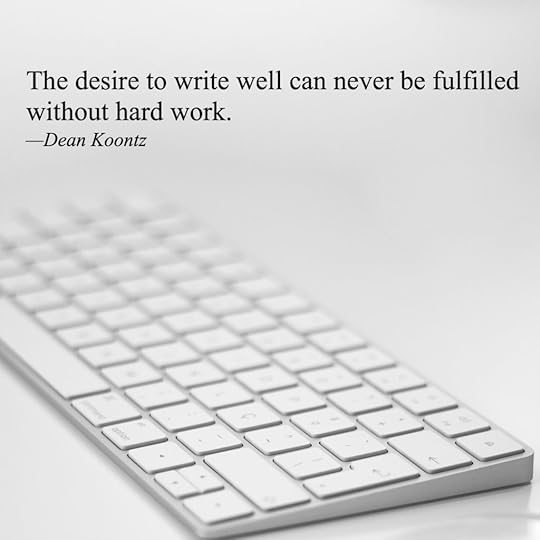
You can make anything by writing. ― C.S. Lewis
Play around. Dive into absurdity and write. Take chances. You will succeed if you are fearless of failure. ― Natalie Goldberg
Exercise the writing muscle every day, even if it is only a letter, notes, a title list, a character sketch, a journal entry. Writers are like dancers, like athletes. Without that exercise, the muscles seize up. ― Jane Yolen
You don’t write because you want to say something; you write because you have something to say. ― F. Scott Fitzgerald
I’m a little pencil in the hand of a writing God, who is sending a love letter to the world. ― Mother Teresa
Words are a lens to focus one’s mind. — Ayn Rand
Get it down. Take chances. It may be bad, but it’s the only way you can do anything really good. — William Faulkner
The difference between fiction and reality? Fiction has to make sense. — Tom Clancy

I can shake off everything as I write; my sorrows disappear, my courage is reborn. ― Anne Frank
If you don’t have time to read, you don’t have the time (or the tools) to write. Simple as that. ― Stephen King
Start writing, no matter what. The water does not flow until the faucet is turned on. — Louis L’Amour
A professional writer is an amateur who didn’t quit. — Richard Bach
If you have other things in your life—family, friends, good productive day work—these can interact with your writing and the sum will be all the richer. — David Brin
I am not at all in a humor for writing; I must write on until I am. — Jane Austen
When I sit down to write, I do not say to myself, ‘I am going to produce a work of art.’ I write because there is some lie that I want to expose, some fact to which I want to draw attention, and my initial concern is to get a hearing. — George Orwell
Fill your paper with the breathings of your heart. — William Wordsworth
Write what disturbs you, what you fear, what you have not been willing to speak about. — Natalie Goldberg
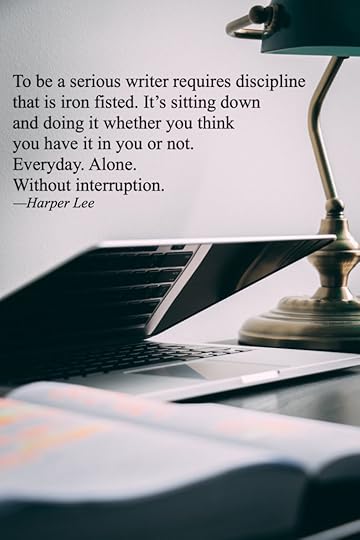
The most valuable of all talents is that of never using two words when one will do. — Thomas Jefferson
No tears in the writer, no tears in the reader. No surprise in the writer, no surprise in the reader. — Robert Frost
People on the outside think there’s something magical about writing, that you go up in the attic at midnight and cast the bones and come down in the morning with a story. But it isn’t like that. You work, and that’s all there is to it. — Harlan Ellison
All you have to do is write one true sentence. Write the truest sentence that you know. — Ernest Hemingway
I would advise any beginning writer to write the first drafts as if no one else will ever read them — without a thought about publication — and only in the last draft to consider how the work will look from the outside. — Anne Tyler
Write what should not be forgotten. — Isabel Allende
Writing a novel is like driving a car at night. You can see only as far as your headlights, but you can make the whole trip that way. — E. L. Doctorow
I write to discover what I know. — Flannery O’Conner
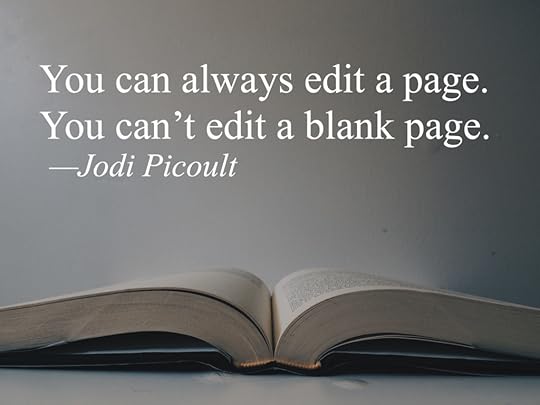
A writer has the duty to be good, not lousy; true, not false; lively, not dull; accurate, not full of error; He should tend to lift people up, not lower them down. Writers do not merely reflect and interpret life, they inform and shape life. — E.B. White
Writing is the painting of the voice. — Voltaire
If it sounds like writing, I rewrite it. — Elmore Leonard
Read, read, read. Read everything — trash, classics, good and bad, and see how they do it. Just like a carpenter who works as an apprentice and studies the master. Read! You’ll absorb it. Then write. If it’s good, you’ll find out. If it’s not, throw it out of the window. — William Faulkner
Talent is cheaper than table salt. What separates the talented from the successful is a lot of hard work. — Steven King
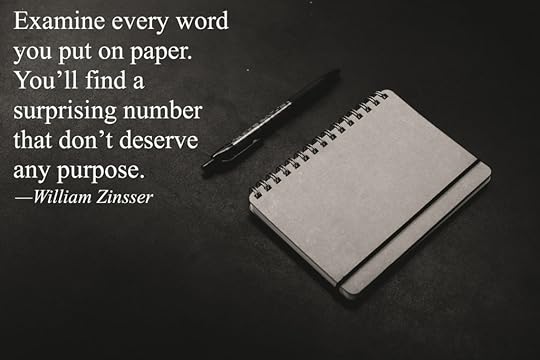
Everybody walks past a thousand story ideas every day. The good writers are the ones who see five or six of them. Most people don’t see any. — Orson Scott
We read five words on the first page of a really good novel and we begin to forget we are reading printed words on a page; we begin to see images. — John Champion Gardner
A true piece of writing is a dangerous thing; it can change your life. — Tobias Wolff
Ready to start writing? Here are a few of my best guides:
How to Write a Book From Start to Finish
How to Write a Short Story That Captivates Your Reader
How to Write a Novel: A 12-Step Guide
How to Overcome Writer’s Block Once and For All: My Surprising Solution
The post Inspirational Writing Quotes From Famous Authors appeared first on Jerry Jenkins | Proven Writing Tips.
January 8, 2020
How to Create a Powerful Character Arc
Page-turning novels have plausible, believable, memorable characters.
Consider these classics:
Gone With The Wind by Margaret MitchellThe Old Man and the Sea by Ernest HemingwayThe Sherlock Holmes novels by Arthur C. DoyleTo Kill a Mockingbird by Harper LeeAnne of Green Gables by L.M. MontgomeryThe Wonderful Wizard of Oz by L. Frank Baum
All have unforgettable lead characters.
Those characters’ growth, their character arcs, makes all the difference.
So, What is Character Arc?
It’s simply the difference between who your character is at the beginning and who he is by the end [I use he inclusively to mean he or she] .
That doesn’t mean he has to go from flawed to fabulous. It just means he faces obstacles—both internal and external—that fundamentally change him..
In the most memorable classics—especially those with happy endings—the character develops skills and strengths that transform him.
The more challenges he faces, the better for your story and for his arc. Bestselling novelist Dean Koontz recommends “plunging your character into terrible trouble as soon as possible.”
Resist the temptation to make his life easy. Only the toughest challenges transform characters.
Click here to download my character arc worksheet.
Types of Character Arcs

1. Positive
The most common and popular arc sees your main character face myriad obstacles and challenges, which—in the end—he overcomes and becomes heroic. Naturally, the bigger the change from beginning to end, the more dramatic the arc.
Example: Perhaps the best known such arc is that of Ebenezer Scrooge in Charles Dickens’s A Christmas Carol. So specific was the author’s portrayal that the very name Scrooge has become synonymous with a selfish, miserly, miserable curmudgeon.
Yet what reader can fail to thrill at the character arc that sees him become an entirely new man, joyful, generous, and loving?
2. Negative
Done well, this arc can be every bit as compelling, though it doesn’t result in a feel-good ending.
The character makes bad decisions and dangerous choices and ends far worse off than when the story began.
Example: In the popular binge worthy TV series Breaking Bad, Walter White begins as a nerdy, naïve, kind, and thoughtful high school science teacher who learns he has cancer.
Out of desperation, because his insurance won’t cover enough of his treatment to keep from bankrupting him, he uses his skills to develop and sell quality methamphetamine, which allows him to afford the treatments and dig his family out of a financial hole.
Even after he finds his cancer is in remission, he embraces the illegal drug culture and in the end destroys his own life, his family, and many other lives.
3. Flat
Too many writers reserve this wholly unacceptable approach for orbital characters or for main characters who may influence the world but remain personally unchanged.
Of course you will often have big part characters that aren’t even named and whose arcs would be irrelevant to the story and to the reader. But it’s otherwise unwise to assume significant secondary characters can have flat arcs. The more readers recognize changes in characters, the more compelling your story.
Examples: Often superheroes appear to have flat character arcs. But this is also a mistake. It proves much more interesting when even a lead character with superpowers faces a personal crisis and initially makes bad choices.
Maybe he responds out of pique or jealousy and must change his ways before succeeding.
How to Create a Powerful Character Arc

To maintain the all-important page-turning energy of your novel, your characters must be credible and believable.
Your lead must grow inwardly throughout.
Begin by asking yourself these questions:
#1 — What does your lead character want or need, and why?
Be sure it’s crucial enough and the stakes high enough to warrant an entire novel.
#2 — What or who is keeping him from what he wants or needs?
To keep your reader engaged and turning pages, you must challenge your character at every turn, removing every support and convenience. Thrust him into the most difficult predicaments you can imagine.
It’s tempting to equip our characters with whatever they need, because that’s the way we’d like our lives to be. But as authors, we should do the opposite. Take away the hero’s house, car, income, maybe even his spouse or lover.
Force your character to act in spite of it all. That will make his character arc the most dramatic.
#3 — What personal flaws and weaknesses emerge during his ordeal, and how do they keep him from his goals?
Readers relate to flawed characters. And every obstacle and challenge your character faces builds new muscles in him (inwardly and outwardly) that equip him to change in the end.
#4 — What inner struggles keep him from achieving his ultimate goal?
How does your character react when the going gets tough?
The best character arc reveals inner transformation, not just a change in circumstances.
#5 — What will he do to accomplish his goals?
Whatever you do, resist the temptation to explain to readers how your character is changing. Make sure they can deduce it from the story by what you show them. Do it right and you should experience an Author Arc as well. That’s a double win: you change and grow too.
That’s a double win: you change and grow too.
#6 — What heroic qualities emerge during the finale?
Your character must do more than realize the errors of his previous thoughts and actions. He must be proactive and flex those new muscles and insights to become the hero he really is.
His change must make sense and result from taking action, doing something.
Get this right and readers will remember your story forever.
Great Character Arcs…
…result from conflict:
Man vs. manMan vs. natureMan vs. GodMan vs. self
Give your hero flaws that aren’t repulsive or irredeemable. And imbue him with a foundation of kindness. A hero who shows respect to those who might be considered beneath him—say a doorman or wait staff—endear him to your reader.
Credible, believable characters with dramatic arcs make for the best, most memorable fiction you can imagine.
Character Arc Worksheet
This character arc worksheet can help Outliners get to know their hero.
But Pantsers (like me) will not likely have the patience for it and might rather dive right into the writing. So, don’t feel obligated to use it. Some Pantsers find it helpful to fill in missing pieces as they write.
Click here to download my character arc worksheet.
The post How to Create a Powerful Character Arc appeared first on Jerry Jenkins | Proven Writing Tips.
January 6, 2020
How to Write a Book From Start to Finish: A Proven Guide
So you want to write a book. Becoming an author can change your life—not to mention give you the ability to impact thousands, even millions, of people.
But writing a book isn’t easy. As a 21-time New York Times bestselling author, I can tell you: It’s far easier to quit than to finish.
You’re going to be tempted to give up writing your book when you run out of ideas, when your own message bores you, when you get distracted, or when you become overwhelmed by the sheer scope of the task.
But what if you knew exactly:
Where to start…What each step entails…How to overcome fear, procrastination, and writer’s block …And how to keep from feeling overwhelmed?
You can write a book—and more quickly than you might think, because these days you have access to more writing tools than ever.
The key is to follow a proven, straightforward, step-by-step plan.
My goal here is to offer you that book-writing plan.
I’ve used the techniques I outline below to write more than 195 books (including the Left Behind series) over the past 45 years. Yes, I realize writing over four books per year on average is more than you may have thought humanly possible.
But trust me—with a reliable blueprint, you can get unstuck and finally write your book.
This is my personal approach to how to write a book. I’m confident you’ll find something here that can change the game for you. So, let’s jump in.
Want to download this 20-step guide so you can read it whenever you wish? Click here.
How to Write a Book From Start to Finish
Part 1: Before You Begin Writing Your Book
Establish your writing space. Assemble your writing tools.
Part 2: How to Start Writing a Book
Break the project into small pieces. Settle on your BIG idea. Construct your outline. Set a firm writing schedule. Establish a sacred deadline. Embrace procrastination (really!). Eliminate distractions. Conduct your research. Start calling yourself a writer.
Part 3: The Book-Writing Itself
Think reader-first. Find your writing voice. Write a compelling opener. Fill your story with conflict and tension. Turn off your internal editor while writing the first draft. Persevere through The Marathon of the Middle. Write a resounding ending.
Part 4: Editing Your Book
Become a ferocious self-editor. Find a mentor.
Part 5: Publishing Your Book
Decide on your publishing avenue. Properly format your manuscript. Set up and grow your author platform.
Part One: Before You Begin Writing Your Book
You’ll never regret—in fact, you’ll thank yourself later—for investing the time necessary to prepare for such a monumental task.
You wouldn’t set out to cut down a huge grove of trees with just an axe. You’d need a chain saw, perhaps more than one. Something to keep them sharp. Enough fuel to keep them running.
You get the picture. Don’t shortcut this foundational part of the process.
Step 1. Establish your writing space.
To write your book, you don’t need a sanctuary. In fact, I started my career on my couch facing a typewriter perched on a plank of wood suspended by two kitchen chairs.
What were you saying about your setup again? We do what we have to do.
And those early days on that sagging couch were among the most productive of my career.
Naturally, the nicer and more comfortable and private you can make your writing lair (I call mine my cave), the better.

Real writers can write anywhere.
Some authors write their books in restaurants and coffee shops. My first full time job was at a newspaper where 40 of us clacked away on manual typewriters in one big room—no cubicles, no partitions, conversations hollered over the din, most of my colleagues smoking, teletype machines clattering.
Cut your writing teeth in an environment like that, and anywhere else seems glorious.
Step 2. Assemble your writing tools.
In the newspaper business, there was no time to hand write our stuff and then type it for the layout guys. So I have always written at a keyboard and still write my books that way.
Most authors do, though some hand write their first drafts and then keyboard them onto a computer or pay someone to do that.
No publisher I know would even consider a typewritten manuscript, let alone one submitted in handwriting.
The publishing industry runs on Microsoft Word, so you’ll need to submit Word document files. Whether you prefer a Mac or a PC, both will produce the kinds of files you need.
And if you’re looking for a musclebound electronic organizing system, you can’t do better than Scrivener. It works well on both PCs and Macs, and it nicely interacts with Word files.
Just remember, Scrivener has a steep learning curve, so familiarize yourself with it before you start writing.
Scrivener users know that taking the time to learn the basics is well worth it.
Tons of other book writing tools exist to help you. I’ve included some of the most well known in my blog post on book writing software and my writing tools page for your reference.
So, what else do you need?
If you are one who handwrites your first drafts, don’t scrimp on paper, pencils, or erasers.
Don’t shortchange yourself on a computer either. Even if someone else is keyboarding for you, you’ll need a computer for research and for communicating with potential agents, editors, publishers.
Get the best computer you can afford, the latest, the one with the most capacity and speed.
Try to imagine everything you’re going to need in addition to your desk or table, so you can equip yourself in advance and don’t have to keep interrupting your work to find things like:
StaplersPaper clipsRulersPencil holdersPencil sharpenersNote padsPrinting paperPaperweightTape dispensersCork or bulletin boardsClocksBookendsReference worksSpace heatersFansLampsBeverage mugsNapkinsTissuesYou name itLast, but most crucial, get the best, most ergonomic chair you can afford.
If I were to start my career again with that typewriter on a plank, I would not sit on that couch. I’d grab another straight-backed kitchen chair or something similar and be proactive about my posture and maintaining a healthy spine.
There’s nothing worse than trying to be creative and immerse yourself in writing while you’re in agony. The chair I work in today cost more than my first car!

If you’ve never used some of the items I listed above and can’t imagine needing them, fine. But make a list of everything you know you’ll need so when the actual writing begins, you’re already equipped.
As you grow as a writer and actually start making money at it, you can keep upgrading your writing space.
Where I work now is light years from where I started. But the point is, I didn’t wait to start writing until I could have a great spot in which to do it.
Part Two: How to Start Writing a Book
Step 1. Break your book into small pieces.
Writing a book feels like a colossal project, because it is! But your manuscript will be made up of many small parts.
An old adage says that the way to eat an elephant is one bite at a time.
Try to get your mind off your book as a 400-or-so-page monstrosity.
It can’t be written all at once any more than that proverbial elephant could be eaten in a single sitting.
See your book for what it is: a manuscript made up of sentences, paragraphs, pages. Those pages will begin to add up, and though after a week you may have barely accumulated double digits, a few months down the road you’ll be into your second hundred pages.
So keep it simple.
Start by distilling your big book idea from a page or so to a single sentence—your premise. The more specific that one-sentence premise, the more it will keep you focused while you’re writing.
But let’s not get ahead of ourselves. Before you can turn your big idea into one sentence, which can then be expanded to an outline, you have to settle on exactly what that big idea is.
Step 2. Settle on your BIG idea.
To be book-worthy, your idea has to be killer.
You need to write something about which you’re passionate, something that gets you up in the morning, draws you to the keyboard, and keeps you there. It should excite not only you, but also anyone you tell about it.
I can’t overstate the importance of this.
If you’ve tried and failed to finish your book before—maybe more than once—it could be that the basic premise was flawed. Maybe it was worth a blog post or an article but couldn’t carry an entire book.
Think The Hunger Games, Harry Potter, or How to Win Friends and Influence People. The market is crowded, the competition fierce. There’s no more room for run-of-the-mill ideas. Your premise alone should make readers salivate.
Go for the big concept book.
How do you know you’ve got a winner? Does it have legs? In other words, does it stay in your mind, growing and developing every time you think of it?
Run it past loved ones and others you trust.
Does it raise eyebrows? Elicit Wows? Or does it result in awkward silences?
The right concept simply works, and you’ll know it when you land on it. Most importantly, your idea must capture you in such a way that you’re compelled to write it. Otherwise you’ll lose interest halfway through and never finish.
Want to download this 20-step guide so you can read it whenever you wish? Click here.
Step 3. Construct your outline.
Writing your book without a clear vision of where you’re going usually ends in disaster.
Even if you’re writing a fiction book and consider yourself a Pantser* as opposed to an Outliner, you need at least a basic structure.
[*Those of us who write by the seat of our pants and, as Stephen King advises, put interesting characters in difficult situations and write to find out what happens]
You don’t have to call it an outline if that offends your sensibilities. But fashion some sort of a directional document that provides structure for your book and also serves as a safety net.
If you get out on that Pantser highwire and lose your balance, you’ll thank me for advising you to have this in place.
Now if you’re writing a nonfiction book, there’s no substitute for an outline.
Potential agents or publishers require this in your proposal. They want to know where you’re going, and they want to know that you know. What do you want your reader to learn from your book, and how will you ensure they learn it?
Fiction or nonfiction, if you commonly lose interest in your book somewhere in what I call the Marathon of the Middle, you likely didn’t start with enough exciting ideas.
That’s why and outline (or a basic framework) is essential. Don’t even start writing until you’re confident your structure will hold up through the end.
You may recognize this novel structure illustration.
Did you know it holds up—with only slight adaptations—for nonfiction books too? It’s self-explanatory for novelists; they list their plot twists and developments and arrange them in an order that best serves to increase tension.
What separates great nonfiction from mediocre? The same structure!
Arrange your points and evidence in the same way so you’re setting your reader up for a huge payoff, and then make sure you deliver.
If your nonfiction book is a memoir, an autobiography, or a biography, structure it like a novel and you can’t go wrong.
But even if it’s a straightforward how-to book, stay as close to this structure as possible, and you’ll see your manuscript come alive.
Make promises early, triggering your reader to anticipate fresh ideas, secrets, inside information, something major that will make him thrilled with the finished product.
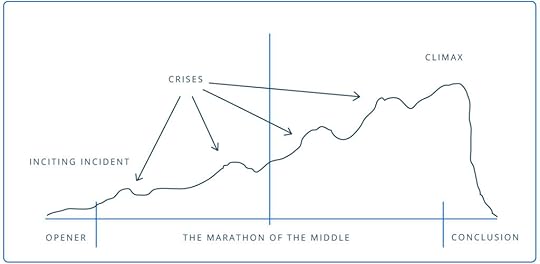
While a nonfiction book may not have as much action or dialogue or character development as a novel, you can inject tension by showing where people have failed before and how your reader can succeed.
You can even make the how-to project look impossible until you pay off that setup with your unique solution.
Keep your outline to a single page for now. But make sure every major point is represented, so you’ll always know where you’re going.
And don’t worry if you’ve forgotten the basics of classic outlining or have never felt comfortable with the concept.
Your outline must serve you. If that means Roman numerals and capital and lowercase letters and then Arabic numerals, you can certainly fashion it that way. But if you just want a list of sentences that synopsize your idea, that’s fine too.
Simply start with your working title, then your premise, then—for fiction, list all the major scenes that fit into the rough structure above.
For nonfiction, try to come up with chapter titles and a sentence or two of what each chapter will cover.
Once you have your one-page outline, remember it is a fluid document meant to serve you and your book. Expand it, change it, play with it as you see fit—even during the writing process.
Step 4. Set a firm writing schedule.
Ideally, you want to schedule at least six hours per week to write your book.
That may consist of three sessions of two hours each, two sessions of three hours, or six one-hour sessions—whatever works for you.
I recommend a regular pattern (same times, same days) that can most easily become a habit. But if that’s impossible, just make sure you carve out at least six hours so you can see real progress.
Having trouble finding the time to write a book? News flash—you won’t find the time. You have to make it.
I used the phrase carve out above for a reason. That’s what it takes.
Something in your calendar will likely have to be sacrificed in the interest of writing time.
Make sure it’s not your family—they should always be your top priority. Never sacrifice your family on the altar of your writing career.
But beyond that, the truth is that we all find time for what we really want to do.
Many writers insist they have no time to write, but they always seem to catch the latest Netflix original series, or go to the next big Hollywood feature. They enjoy concerts, parties, ball games, whatever.
How important is it to you to finally write your book? What will you cut from your calendar each week to ensure you give it the time it deserves?
A favorite TV show?An hour of sleep per night? (Be careful with this one; rest is crucial to a writer.)A movie?A concert?A party?
Successful writers make time to write.
When writing becomes a habit, you’ll be on your way.
Step 5. Establish a sacred deadline.
Without deadlines, I rarely get anything done. I need that motivation.
Admittedly, my deadlines are now established in my contracts from publishers.
If you’re writing your first book, you probably don’t have a contract yet. To ensure you finish your book, set your own deadline—then consider it sacred.
Tell your spouse or loved one or trusted friend. Ask that they hold you accountable.
Now determine—and enter in your calendar—the number of pages you need to produce per writing session to meet your deadline. If it proves unrealistic, change the deadline now.
If you have no idea how many pages or words you typically produce per session, you may have to experiment before you finalize those figures.
Say you want to finish a 400-page manuscript by this time next year.
Divide 400 by 50 weeks (accounting for two off-weeks), and you get eight pages per week.
Divide that by your typical number of writing sessions per week and you’ll know how many pages you should finish per session.
Now is the time to adjust these numbers, while setting your deadline and determining your pages per session.
Maybe you’d rather schedule four off weeks over the next year. Or you know your book will be unusually long.
Change the numbers to make it realistic and doable, and then lock it in. Remember, your deadline is sacred.
Step 6. Embrace procrastination (really!).
You read that right. Don’t fight it; embrace it.
You wouldn’t guess it from my 195+ published books, but I’m the king of procrastinators.
Surprised?
Don’t be. So many authors are procrastinators that I’ve come to wonder if it’s a prerequisite.
The secret is to accept it and, in fact, schedule it.
I quit fretting and losing sleep over procrastinating when I realized it was inevitable and predictable, and also that it was productive.
Sound like rationalization?
Maybe it was at first. But I learned that while I’m putting off the writing, my subconscious is working on my book. It’s a part of the process. When you do start writing again, you’ll enjoy the surprises your subconscious reveals to you.
So, knowing procrastination is coming, book it on your calendar.
Take it into account when you’re determining your page quotas. If you have to go back in and increase the number of pages you need to produce per session, do that (I still do it all the time).
But—and here’s the key—you must never let things get to where that number of pages per day exceeds your capacity.
It’s one thing to ratchet up your output from two pages per session to three. But if you let it get out of hand, you’ve violated the sacredness of your deadline.
How can I procrastinate and still meet more than 190 deadlines?
Because I keep the deadlines sacred.
Step 7. Eliminate distractions to stay focused.
Are you as easily distracted as I am?
Have you found yourself writing a sentence and then checking your email? Writing another and checking Facebook? Getting caught up in the pictures of 10 Sea Monsters You Wouldn’t Believe Actually Exist?
Then you just have to check out that precious video from a talk show where the dad surprises the family by returning from the war.
That leads to more and more of the same. Once I’m in, my writing is forgotten, and all of a sudden the day has gotten away from me.
The answer to these insidious timewasters?
Look into these apps that allow you to block your email, social media, browsers, game apps, whatever you wish during the hours you want to write. Some carry a modest fee, others are free.
Freedom app FocusWriter StayFocusd WriteRoom
Step 8. Conduct your research.
Yes, research is a vital part of the process, whether you’re writing fiction or nonfiction.
Fiction means more than just making up a story.
Your details and logic and technical and historical details must be right for your novel to be believable.
And for nonfiction, even if you’re writing about a subject in which you’re an expert—as I’m doing here—getting all the facts right will polish your finished product.
In fact, you’d be surprised at how many times I’ve researched a fact or two while writing this blog post alone.

The last thing you want is even a small mistake due to your lack of proper research.
Regardless the detail, trust me, you’ll hear from readers about it.
Your credibility as an author and an expert hinges on creating trust with your reader. That dissolves in a hurry if you commit an error.
My favorite research resources:
World Almanacs : These alone list almost everything you need for accurate prose: facts, data, government information, and more. For my novels, I often use these to come up with ethnically accurate character names. The Merriam-Webster Thesaurus : The online version is great, because it’s lightning fast. You couldn’t turn the pages of a hard copy as quickly as you can get where you want to onscreen. One caution: Never let it be obvious you’ve consulted a thesaurus. You’re not looking for the exotic word that jumps off the page. You’re looking for that common word that’s on the tip of your tongue. WorldAtlas.com : Here you’ll find nearly limitless information about any continent, country, region, city, town, or village. Names, monetary units, weather patterns, tourism info, and even facts you wouldn’t have thought to search for. I get ideas when I’m digging here, for both my novels and my nonfiction books.
Step 9. Start calling yourself a writer.
Your inner voice may tell you, “You’re no writer and you never will be. Who do you think you are, trying to write a book?”
That may be why you’ve stalled at writing your book in the past.
But if you’re working at writing, studying writing, practicing writing, that makes you a writer. Don’t wait till you reach some artificial level of accomplishment before calling yourself a writer.
A cop in uniform and on duty is a cop whether he’s actively enforced the law yet or not. A carpenter is a carpenter whether he’s ever built a house.
Self-identify as a writer now and you’ll silence that inner critic—who, of course, is really you.
Talk back to yourself if you must. It may sound silly, but acknowledging yourself as a writer can give you the confidence to keep going and finish your book.
Are you a writer? Say so.
Want to download this 20-step guide so you can read it whenever you wish? Click here.
Part Three: The Book-Writing Itself
Step 1. Think reader-first.
This is so important that that you should write it on a sticky note and affix it to your monitor so you’re reminded of it every time you write.
Every decision you make about your manuscript must be run through this filter.
Not you-first, not book-first, not editor-, agent-, or publisher-first. Certainly not your inner circle- or critics-first.
Reader-first, last, and always.
If every decision is based on the idea of reader-first, all those others benefit anyway.
When fans tell me they were moved by one of my books, I think back to this adage and am grateful I maintained that posture during the writing.
Does a scene bore you? If you’re thinking reader-first, it gets overhauled or deleted.
Where to go, what to say, what to write next? Decide based on the reader as your priority.
Whatever your gut tells you your reader would prefer, that’s your answer.
Whatever will intrigue him, move him, keep him reading, those are your marching orders.
So, naturally, you need to know your reader. Rough age? General interests? Loves? Hates? Attention span?
When in doubt, look in the mirror.
The surest way to please your reader is to please yourself. Write what you would want to read and trust there is a broad readership out there that agrees.
Step 2. Find your writing voice.
Discovering your voice is nowhere near as complicated as some make it out to be.
You can find yours by answering these quick questions:
What’s the coolest thing that ever happened to you?Who’s the most important person you told about it?What did you sound like when you did?That’s your writing voice. It should read the way you sound at your most engaged.
That’s all there is to it.
If you write fiction and the narrator of your book isn’t you, go through the three-question exercise on the narrator’s behalf—and you’ll quickly master the voice.
Here’s a blog I posted that’ll walk you through the process.
Step 3. Write a compelling opener.
If you’re stuck because of the pressure of crafting the perfect opening line for your book, you’re not alone.
And neither is your angst misplaced.
This is not something you should put off and come back to once you’ve started on the rest of the first chapter.

Oh, it can still change if the story dictates that. But settling on a good one will really get you off and running.
It’s unlikely you’ll write a more important sentence than your first one, whether you’re writing fiction or nonfiction. Make sure you’re thrilled with it and then watch how your confidence—and momentum—soars.
Most great first lines fall into one of these categories:
1. Surprising
Fiction: “It was a bright cold day in April, and the clocks were striking thirteen.” —George Orwell, Nineteen Eighty-Four
Nonfiction: “By the time Eustace Conway was seven years old, he could throw a knife accurately enough to nail a chipmunk to a tree.” —Elizabeth Gilbert, The Last American Man
2. Dramatic Statement
Fiction: “They shoot the white girl first.” —Toni Morrison, Paradise
Nonfiction: “I was five years old the first time I ever set foot in prison.” —Jimmy Santiago Baca, A Place to Stand
3. Philosophical
Fiction: “Happy families are all alike; every unhappy family is unhappy in its own way.” —Leo Tolstoy, Anna Karenina
Nonfiction: “It’s not about you.” —Rick Warren, The Purpose Driven Life
4. Poetic
Fiction: “When I finally caught up with Abraham Trahearne, he was drinking beer with an alcoholic bulldog named Fireball Roberts in a ramshackle joint just outside of Sonoma, California, drinking the heart right out of a fine spring afternoon. —James Crumley, The Last Good Kiss
Nonfiction: “The village of Holcomb stands on the high wheat plains of western Kansas, a lonesome area that other Kansans call ‘out there.’” —Truman Capote, In Cold Blood
Great opening lines from other classics may give you ideas for yours. Here’s a list of famous openers.
Step 4. Fill your story with conflict and tension.
Your reader craves conflict, and yes, this applies to nonfiction readers as well.
In a novel, if everything is going well and everyone is agreeing, your reader will soon lose interest and find something else to do.
Are two of your characters talking at the dinner table? Have one say something that makes the other storm out.
Some deep-seeded rift in their relationship has surfaced—just a misunderstanding, or an injustice?
Thrust people into conflict with each other.
That’ll keep your reader’s attention.
Certain nonfiction genres won’t lend themselves to that kind of conflict, of course, but you can still inject tension by setting up your reader for a payoff in later chapters. Check out some of the current bestselling nonfiction works to see how writers accomplish this.
Somehow they keep you turning those pages, even in a simple how-to title.
Tension is the secret sauce that will propel your reader through to the end.
And sometimes that’s as simple as implying something to come.
Step 5. Turn off your internal editor while writing the first draft.
Many of us perfectionists find it hard to write a first draft—fiction or nonfiction—without feeling compelled to make every sentence exactly the way we want it.
That voice in your head that questions every word, every phrase, every sentence, and makes you worry you’re being redundant or have allowed cliches to creep in—well, that’s just your editor alter ego.
He or she needs to be told to shut up.

This is not easy.
Deep as I am into a long career, I still have to remind myself of this every writing day. I cannot be both creator and editor at the same time. That slows me to a crawl, and my first draft of even one brief chapter could take days.
Our job when writing that first draft is to get down the story or the message or the teaching—depending on your genre.
It helps me to view that rough draft as a slab of meat I will carve tomorrow.
I can’t both produce that hunk and trim it at the same time.
A cliche, a redundancy, a hackneyed phrase comes tumbling out of my keyboard, and I start wondering whether I’ve forgotten to engage the reader’s senses or aimed for his emotions.
That’s when I have to chastise myself and say, “No! Don’t worry about that now! First thing tomorrow you get to tear this thing up and put it back together again to your heart’s content!”
Imagine yourself wearing different hats for different tasks, if that helps—whatever works to keep you rolling on that rough draft. You don’t need to show it to your worst enemy or even your dearest love. This chore is about creating. Don’t let anything slow you down.
Some like to write their entire first draft before attacking the revision. As I say, whatever works.
Doing it that way would make me worry I’ve missed something major early that will cause a complete rewrite when I discover it months later. I alternate creating and revising.
The first thing I do every morning is a heavy edit and rewrite of whatever I wrote the day before. If that’s ten pages, so be it. I put my perfectionist hat on and grab my paring knife and trim that slab of meat until I’m happy with every word.
Then I switch hats, tell Perfectionist Me to take the rest of the day off, and I start producing rough pages again.
So, for me, when I’ve finished the entire first draft, it’s actually a second draft because I have already revised and polished it in chunks every day.
THEN I go back through the entire manuscript one more time, scouring it for anything I missed or omitted, being sure to engage the reader’s senses and heart, and making sure the whole thing holds together.
I do not submit anything I’m not entirely thrilled with.
I know there’s still an editing process it will go through at the publisher, but my goal is to make my manuscript the absolute best I can before they see it.
Compartmentalize your writing vs. your revising and you’ll find that frees you to create much more quickly.
Step 6. Persevere through The Marathon of the Middle.
Most who fail at writing a book tell me they give up somewhere in what I like to call The Marathon of the Middle.
That’s a particularly rough stretch for novelists who have a great concept, a stunning opener, and they can’t wait to get to the dramatic ending. But they bail when they realize they don’t have enough cool stuff to fill the middle.
They start padding, trying to add scenes just for the sake of bulk, but they’re soon bored and know readers will be too.
This actually happens to nonfiction writers too.
The solution there is in the outlining stage, being sure your middle points and chapters are every bit as valuable and magnetic as the first and last.
If you strategize the progression of your points or steps in a process—depending on nonfiction genre—you should be able to eliminate the strain in the middle chapters.
For novelists, know that every book becomes a challenge a few chapters in. The shine wears off, keeping the pace and tension gets harder, and it’s easy to run out of steam.
But that’s not the time to quit. Force yourself back to your structure, come up with a subplot if necessary, but do whatever you need to so your reader stays engaged.
Fiction writer or nonfiction author, The Marathon of the Middle is when you must remember why you started this journey in the first place.
It isn’t just that you want to be an author. You have something to say. You want to reach the masses with your message.
Yes, it’s hard. It still is for me—every time. But don’t panic or do anything rash, like surrendering. Embrace the challenge of the middle as part of the process. If it were easy, anyone could do it.
Step 7. Write a resounding ending.
This is just as important for your nonfiction book as your novel. It may not be as dramatic or emotional, but it could be—especially if you’re writing a memoir.
But even a how-to or self-help book needs to close with a resounding thud, the way a Broadway theater curtain meets the floor.
How do you ensure your ending doesn’t fizzle?
Don’t rush it. Give readers the payoff they’ve been promised. They’ve invested in you and your book the whole way. Take the time to make it satisfying.Never settle for close enough just because you’re eager to be finished. Wait till you’re thrilled with every word, and keep revising until you are.If it’s unpredictable, it had better be fair and logical so your reader doesn’t feel cheated. You want him to be delighted with the surprise, not tricked.If you have multiple ideas for how your book should end, go for the heart rather than the head, even in nonfiction. Readers most remember what moves them.
Want to download this 20-step guide so you can read it whenever you wish? Click here.
Part Four: Rewriting Your Book
Step 1. Become a ferocious self-editor.
Agents and editors can tell within the first two pages whether your manuscript is worthy of consideration. That sounds unfair, and maybe it is. But it’s also reality, so we writers need to face it.
How can they often decide that quickly on something you’ve devoted months, maybe years, to?
Because they can almost immediately envision how much editing would be required to make those first couple of pages publishable. If they decide the investment wouldn’t make economic sense for a 300-400-page manuscript, end of story.
Your best bet to keep an agent or editor reading your manuscript?
You must become a ferocious self-editor. That means:
Omit needless wordsChoose the simple word over one that requires a dictionaryAvoid subtle redundancies, like “He thought in his mind…” (Where else would someone think?)Avoid hedging verbs like almost frowned, sort of jumped, etc.Generally remove the word that—use it only when absolutely necessary for clarityGive the reader credit and resist the urge to explain, as in, “She walked through the open door.” (Did we need to be told it was open?)Avoid too much stage direction (what every character is doing with every limb and digit)Avoid excessive adjectives Show, don’t tell And many more
For my full list and how to use them, click here. (It’s free.)
When do you know you’re finished revising? When you’ve gone from making your writing better to merely making it different. That’s not always easy to determine, but it’s what makes you an author.
Step 2. Find a mentor.
Get help from someone who’s been where you want to be.
Imagine engaging a mentor who can help you sidestep all the amateur pitfalls and shave years of painful trial-and-error off your learning curve.
Just make sure it’s someone who really knows the writing and publishing world. Many masquerade as mentors and coaches but have never really succeeded themselves.
Look for someone widely-published who knows how to work with agents, editors, and publishers.
There are many helpful mentors online. I teach writers through this free site, as well as in my members-only Writers Guild.
Part 5: Publishing Your Book
Step 1. Decide on your publishing avenue.
In simple terms, you have two options when it comes to publishing your book:
1. Traditional publishing
Traditional publishers take all the risks. They pay for everything from editing, proofreading, typesetting, printing, binding, cover art and design, promotion, advertising, warehousing, shipping, billing, and paying author royalties.
2. Self-publishing
Everything is on you. You are the publisher, the financier, the decision-maker. Everything listed above falls to you. You decide who does it, you approve or reject it, and you pay for it. The term self-publishing is a bit of a misnomer, however, because what you’re paying for is not publishing, but printing.
Both avenues are great options under certain circumstances.
Not sure which direction you want to take? Click here to read my in-depth guide to publishing a book. It’ll show you the pros and cons of each, what each involves, and my ultimate recommendation.
Step 2: Properly format your manuscript.
Regardless whether you traditionally or self-publish your book, proper formatting is critical.
Why?
Because poor formatting makes you look like an amateur.
Readers and agents expect a certain format for book manuscripts, and if you don’t follow their guidelines, you set yourself up for failure.
Best practices when formatting your book:
Use 12-point typeUse a serif font; the most common is Times RomanDouble space your manuscriptNo extra space between paragraphsOnly one space between sentencesIndent each paragraph half an inch (setting a tab, not using several spaces)Text should be flush left and ragged right, not justifiedIf you choose to add a line between paragraphs to indicate a change of location or passage of time, center a typographical dingbat (like ***) on the lineBlack text on a white background onlyOne-inch margins on the top, bottom, and sides (the default in Word)Create a header with the title followed by your last name and the page number. The header should appear on each page other than the title page.
If you need help implementing these formatting guidelines, click here to read my in-depth post on formatting your manuscript.
Step 3. Set up your author website and grow your platform.
All serious authors need a website. Period.
Because here’s the reality of publishing today…
You need an audience to succeed.
If you want to traditionally publish, agents and publishers will Google your name to see if you have a website and a following.
If you want to self-publish, you need a fan base.
And your author website serves as a hub for your writing, where agents, publishers, readers, and fans can learn about your work.
Don’t have an author website yet? Click here to read my tutorial on setting this up.
You Have What It Takes to Write a Book
Writing a book is a herculean task, but that doesn’t mean it can’t be done.
You can do this.
Take it one step at a time and vow to stay focused. And who knows, maybe by this time next year you’ll be holding a published copy of your book. :)
I’ve created an exclusive writing guide called How to Maximize Your Writing Time that will help you stay on track and finish writing your book.
Get your FREE copy by clicking the button below.
Click here to download How to Maximize Your Writing Time.
The post How to Write a Book From Start to Finish: A Proven Guide appeared first on Jerry Jenkins | Proven Writing Tips.
January 1, 2020
Your Ultimate Guide to Writing Contests Through 2021
Regardless where you are on your writing journey—from wannabe to bestseller—you can benefit from entering contests.
Why?
Because the right contest can tell you:
Where you standHow you measure up against the competitionWhat you still need to learn
Not to mention, you could win prizes. :)
That’s why my team and I conducted extensive research to not only find free, high-quality writing contests, but to also give you the best chance to win.
Last Updated: 1/1/20
Need help writing your novel? Click here to download Jerry’s ultimate 12-step guide.
Free Writing Contests Through 2021
53-Word Story Contest
Prize: Publication, a free book from Press 53
Deadline: Frequent contests
Sponsor: Prime Number Magazine
Description: Each month Prime Number Magazine invites writers to submit a 53-word story based on a prompt.
The Jeff Sharlet Memorial Award for Veterans
Prize:
1st: $1,000 and publication in The Iowa Review
2nd: $750
3rd (3 selected): $500
Deadline: 5/1/20 – 5/31/20
Sponsor: The Iowa Review
Description: Due to a donation from the family of veteran and antiwar author, Jeff Sharlet, The Iowa Review is able to hold The Jeff Sharlet Memorial Award for Veterans. Note: Only U.S. military veterans and active duty personnel may submit writing in any genre about any topic.
St. Francis College Literary Prize
Prize: $50,000
Deadline: TBD 2021
Sponsor: St. Francis College
Description: For mid-career authors who have just published their 3rd, 4th, or 5th fiction book. Self-published books and English translations are also considered.
New Writers Awards
Prize: The winning authors tour several colleges, giving readings, lecturing, visiting classes, conducting workshops, and publicizing their books. Each writer receives an honorarium of at least $500 from each college visited, as well as travel expenses, hotel accommodations, and hospitality.
Deadline: TBD 2020
Sponsor: Great Lakes Colleges Association
Description: Every year since 1970, the Association has honored newly published writers with an award for a first published volume of poetry, fiction, and creative nonfiction. Note: Publishers (not the writers) are invited to submit works that “emphasize literary excellence.” All entries must be written in English and published in the United States or Canada.
Young Lions Fiction Award
Prize: $10,000
Deadline: 6/11/20
Sponsor: New York Public Library
Description: Each Spring, the Library gives a writer 35 years old or younger $10,000 for a novel or a collection of short stories. This award seeks to encourage young and emerging writers of contemporary fiction.
The Iowa Short Fiction Award
Prize: Publication in the University of Iowa Press
Deadline: 9/30/20
Sponsor: University of Iowa Press
Description: Seeking 150-page (or longer) collections of fiction by writers who have not previously traditionally published a novel or fiction collection.
Pen/Faulkner Award for Fiction
Prize: $15,000
Deadline: TBD 2020
Sponsor: Pen/Faulkner Foundation
Description: Mary Lee established the Award in 1980 to recognize excellent literary fiction. It accepts published books and is peer-juried. The winner is honored as “first among equals.”
Friends of American Writers Literary Award
Prize: $1,000 – $3,000
Deadline: TBD 2020
Sponsor: Friends of American Writers Chicago
Description: Current or former residents of the American Midwest (or authors whose book takes place in the Midwest) are invited to submit to the FAW Literary Award. Published novels or nonfiction books are welcome. Authors must have three or fewer books published, including the submission.
Anisfield-Wolf Book Awards
Prize: $10,000
Deadline: 12/31/20
Sponsor: Cleveland Foundation
Description: The Award seeks fiction, poetry, and nonfiction books published the previous year (books published in 2019 are eligible for the 2020 prize) “that contribute to our understanding of racism and our appreciation of cultural diversity.” Self-published work not accepted.
Cabell First Novelist Award
Prize: $5,000
Deadline: 12/31/20
Sponsor: Virginia Commonwealth University
Description: Seeks to honor first-time novelists “who have navigated their way through the maze of imagination and delivered a great read.” Novels published the previous year are accepted.
The Gabo Prize
Prize: $200
Deadline: Every February and August
Sponsor: Lunch Ticket
Description: Awards translators and authors of multilingual texts (poetry and prose) with $200 and publication in Lunch Ticket.
Transitions Abroad Expatriate and Work Abroad Writing Contest
Prize:
First: $500
Second: $150
Third: $100
All Finalists: $50
Deadline: 9/15/20
Sponsor: Transitions Abroad Publishing, Inc.
Description: Seeking inspiring articles or practical mini-guides that also provide in-depth descriptions of your experience moving, living, and working abroad (including teaching, internships, volunteering, short-term jobs, etc.). Work should be between 1,200-3,000 words. All writers welcome.
Short Fiction Prize
Prize: $1,000 and a scholarship to the 2021 Southampton Writers Conference.
Deadline: 6/1/20
Sponsor: Stony Brook University
Description: Seeking short stories by undergraduates at American or Canadian colleges.
The Wallace Stegner Prize in Environmental Humanities
Prize: $5,000 and publication.
Deadline: 12/30/21
Sponsor: The University of Utah Press
Description: Wallace Stegner was a student of the American West, an environmental spokesman, and a creative writing teacher. In his memory, the University of Utah Press seeks book-length monographs in the field of environmental humanities. Projects focusing on the American West preferred.
Drue Heinz Literature Prize
Prize: $15,000 and publication
Deadline: May 1 – June 30 yearly
Sponsor: University of Pittsburgh Press
Description: Seeks short fiction or novella collections. Writers who have published a novel or a book-length collection of fiction with a traditional book publisher, or a minimum of three short stories or novellas in magazines or journals of national distribution are accepted.
Ernest J. Gaines Award for Literary Excellence
Prize: $15,000
Deadline: TBD
Sponsor: Baton Rouge Area Foundation
Description: Honors novels and story collections by African American writers. Entries that will be published in 2019 are accepted.
Brooklyn Nonfiction Prize
Prize: $500
Deadline: TBD
Sponsor: Brooklyn Film & Arts Festival
Description: Showcases essays set in Brooklyn. Five authors will be asked to read their pieces at the Brooklyn Film & Arts Festival.
International Flash Fiction Competition
Prize:
First: $20,000
Three runners-up: $2,000
Deadline: TBD
Sponsor: The César Egido Serrano Foundation
Description: With over 40,000 participants last year, this prize invites authors to submit flash fiction in Spanish, English, Arabic, and Hebrew.
David J. Langum, Sr. Prize in American Historical Fiction
Prize: $1,000
Deadline: 12/1/20
Sponsor: The Langum Foundation
Description: To make American history accessible to general educated readers, the Foundation seeks American historical novels published in the previous year. Novels should take place in America before 1950 (split-time novels accepted). Novels set outside American but including American values and characters accepted (such as about the American military). Self-published novels not accepted.
W.Y. Boyd Literary Award
Prize: $5,000
Deadline: 12/1/20
Sponsor: American Library Association
Description: The Association seeks Military fiction published in the previous year. Children’s books not accepted—young adult and adult novels only.
BCALA Literary Awards
Prize: $500
Deadline: TBD
Sponsor: Black Caucus of the American Library Association
Description: For literary fiction, nonfiction, and poetry books as well as first novels. Books written by African Americans and published the previous year accepted.
John Gardner Fiction Book Award
Prize: $1,000
Deadline: 2/1/20
Sponsor: Binghamton University
Description: Seeks original novels or collections of fiction published the previous year.
Nelson Algren Short Story Award
Prize:
First: $3,500
Finalists (5): $750
Deadline: 2/17/20
Sponsor: Chicago Tribune
Description: Original, unpublished short stories under 8,000 words accepted for this award given in honor of the late Chicago writer.
Graywolf Press Nonfiction Prize
Prize: $12,000 and publication
Deadline: 1/31/20
Sponsor: Graywolf Press
Description: Awarded to the most promising and innovative literary nonfiction project by a writer not yet established in the genre. Accepts memoirs, essays, biographies, histories, and more, but emphasizes innovation over straightforward memoirs.
New Voices Award
Prize: $2,000 and publication ($1,000 for the Honor Award winner)
Deadline: 8/31/20
Sponsor: Lee and Low Books
Description: Seeks a children’s picture book manuscript by a writer of color or a Native/Indigenous writer. Only U.S. residents who have not previously published a children’s picture book are eligible. Fiction, nonfiction, and poetry accepted that addresses the needs of children of color and Native nations by providing stories with which they can identify and which promote a greater understanding of one another. Work should be under 1,500 words.
St. Martin’s Minotaur / Mystery Writers of America First Crime Novel Competition
Prize: Publication and a $10,000 advance
Deadline: 1/3/20
Sponsor: Minotaur Books and Mystery Writers of America
Description: Seeks mysteries by writers who have never published a novel (not including self-publishing). Serious crime must be at the heart of the work.
Stowe Prize
Prize: $10,000
Deadline: TBD
Sponsor: Harriet Beecher Stowe Center
Description: Named for the abolitionist and author of Uncle Tom’s Cabin, recognizes a U.S. author whose work has made a tangible impact on a social justice issue critical to contemporary society. Can be for a single work or a body of work (fiction or nonfiction) within two years of submission.
ServiceScape Short Story Award
Prize: $1,000
Deadline: 11/30/20
Sponsor: ServiceScape
Description: Accepts original, unpublished work (5,000 words or fewer) in any genre.
The Marfield Prize
Prize: $10,000
Deadline: TBD
Sponsor: The Arts Club of Washington
Description: Celebrates nonfiction books about an artistic discipline published the previous year.
Narrative Prize
Prize: $4,000
Deadline: 6/15/20
Sponsor: Narrative
Description: Awarded annually for the best short story, novel excerpt, poem, one-act play, graphic story, or work of literary nonfiction published by a new or emerging writer in Narrative.
Bacopa Literary Review Contest
Prize: $300
Deadline: 5/21/20
Sponsor: The Writers Alliance of Gainesville
Description: Seeks work in the categories of haiku, poetry, prose poetry, fiction, and creative nonfiction
Jim Baen Memorial Short Story Award
Prize: $.08 per word and publication
Deadline: 2/1/20
Sponsor: National Space Society and Baen Books
Description: The National Space Society and Baen Books applaud the role that science fiction plays in advancing real science and have teamed up to sponsor this short fiction contest in memory of Jim Baen.
Hektoen Grand Prix Essay Competition
1st Prize: $3,000
2nd Prize: $800
Deadline: 1/25/20
Sponsor: Hektoen Institute of Medicine
Description: Seeks essays about medicine under 1,600 words. Topics might include art, history, literature, education, etc., as they relate to medicine.
James Laughlin Award
Prize: $5,000, an all-expenses-paid weeklong residency at The Betsy Hotel in Miami Beach, Florida, and distribution of the winning book to approximately one thousand Academy of American Poets members.
Deadline: Submissions accepted yearly between January 1 and May 15
Sponsor: The Academy of American Poets
Description: Offered since 1954, the James Laughlin Award is given to recognize and support a second book of poetry forthcoming in the next calendar year.
Parsec Short Story Contest
Prize:
First: $200
Second: $100
Third: $50
Deadline: 4/15/20
Sponsor: Parsec, Inc.
Description: This annual contest seeks science fiction, fantasy, and horror short stories from non-professional writers.
Owl Canyon Press Short Story Hackathon
Prize:
First: $3,000
Second: $2,000
Third: $1,000
Finalists (24): Publication
Deadline: TBD 2020
Sponsor: Owl Canyon Press
Description: Seeks stories with 50 paragraphs, but the first and twentieth paragraphs are provided by the judges.
Tony Hillerman Prize
Prize: Publication and a $10,000 advance
Deadline: TBD 2020
Sponsor: Western Writers of America and St. Martin’s Press, LLC
Description: Seeks unpublished mystery novels set in the Southwest by authors who haven’t previously published a mystery novel.
The Restless Books Prize for New Immigrant Writing
Prize: $10,000 and publication
Deadline: 3/31/20
Sponsor: Restless Books
Description: Looking for complete, unpublished fiction manuscripts from emerging writers (unpublished) who are first-generation residents of their country.
Need help writing your novel? Click here to download Jerry’s ultimate 12-step guide.
Related Posts:
How to Write a Book: Everything You Need to Know in 20 Steps
How to Publish a Book: My Ultimate Guide from 40+ Years of Experience
How to Overcome Writer’s Block Once and for All: My Surprising Solution
The post Your Ultimate Guide to Writing Contests Through 2021 appeared first on Jerry Jenkins | Proven Writing Tips.
December 23, 2019
Unique Gifts for Writers
I LOVE finding just the right gift for the people I most care about, don’t you?
Believe it or not, writers are easy—and fun—to buy for.
If you thought there weren’t many options beyond:
Paper and pensAn Amazon or bookstore gift cardA notebookA book by their favorite author
You’ll be happy with what my team and I have found!
Many great options exist, and I can even save you the time of searching for them.
Here, then, is a massive list of gifts for writers.
(Full disclosure: If you decide to purchase an item after clicking one of the links below, I may get a small commission at no extra cost to you. I promise to invest any and all such commissions directly into writer training.)
CONTENTS
Gifts for Young Writers Gifts for Aspiring Authors Home Decor Gifts for Writers Gifts Any Writer Would Love Tech Gifts for Writers Writing Tools High-Ticket Gifts for Authors

Gifts for Young Writers
The Writer’s Toolbox
Created by a creative writing teacher, the box is full of exercises designed to teach kids how to kickstart story ideas and sprinkle in plot twists.
Price: $22.11
Mad Libs Book
Mad Libs is a fun way for kids to practice different parts of speech and learn storytelling.
Includes Mad Libs about world history, dogs, unicorns, road trips, and even Frozen.
Price: From $4.99
Man Bites Dog
Have a budding journalist or blogger in the family? Man Bites Dog is a card game that can help them learn to write outrageous, attention-grabbing headlines.
Price: $7.85
The Storymatic Game
Draw two gold cards for the main character’s two defining characteristics and a copper card to reveal the situation or motivation.
Helps aspiring writers practice storytelling and stretch their imaginations.
Price: $29.95
Spilling Ink: A Young Writer’s Handbook 1st Edition
Spilling Ink is full of practical advice to give ambitious authors the direction to craft spellbinding stories.
Price: $7.79
642 Big Things to Write About: Young Writer’s Edition
642 Big Things to Write About is a journal full of prompts encouraging writers to think outside the box. For a budding writer who wants to practice short story writing or novel plotting.
Price: $19.06
Gamewright Rory’s Story Cubes
Rory’s Story Cubes is a pocket-sized creative story generator. Simply role the nine cubes and let your imagination run wild with an infinite number of ways to play. Contributes to literacy development, problem-solving, and storytelling abilities.
Price: $19.99
“Write On” T-shirt
From Etsy.
Choose from a range of colors and styles.
Price: From $22
Gifts for Aspiring Authors

Writing Magic: Creating Stories that Fly
Writing Magic teaches writers of all ages how to turn their ideas into spellbinding stories.
How to find ideasCreating intriguing beginnings and satisfying endings Character developmentWhat to do when you’re feeling stuck
Price: $6.98
Writer’s Market 2020
The Writer’s Market 2020 is one of the best gifts for writers ready to start making money from their work.
The comprehensive guide includes contact information for magazines, publishers, and literary agents who can help your writer get published.
Also includes information on:
Literary competitionsSubmission informationHow to market your writingCreating a business plan Crafting an attention-grabbing query letter
Price: From $14.99
The Elements of Style (Illustrated)
I read this at least once every year. The Illustrated Elements of Style guide is the go-to manual on clear, direct writing.
Price: $11.49
Writer’s Digest Critiques
If your writer has finished a manuscript and is eager to know if it has merit, consider gifting them a Writer’s Digest Critique. Few things can be more valuable and instructive to an aspiring writer than expert input.
Price: Varies by length of submission
On Writing by Stephen King
On Writing, is one of my favorites and is among the best books I’ve read on the craft.
Full of anecdotes and tips, it tells his story of going from unknown and unpublished to one of the most celebrated writers of our day..
Warning: Not for kids. Contains adult language.
Price: $15.14
Plot & Structure by James Scott Bell
Plot & Structure is a book every writer should read. Written by a longtime friend and colleague, it’s a resource I often refer to often in my blog. A great gift for beginners to experts.
Price: $12.77
Writer Emergency Pack
Have a writer friend who’s feeling stuck? The Writer Emergency Pack could be the perfect gift.
It helps weed out plot holes, spice up bland characters, and pose questions that lead to intriguing solutions.
Price: $9.99
The 3 A.M. Epiphany: Uncommon Writing Exercises that Transform Your Fiction
The 3 A.M. Epiphany takes authors out of their comfort zones and throws them into impossible situations — making for compelling fiction.
Designed to stretch the imagination and transform stale writing.
Price: $12.75
The Emotion Thesaurus: A Writer’s Guide to Character Expression
The Emotion Thesaurus includes over 130 entries on facial expressions, mental responses, and body language to help writers show characters’ emotions, rather than telling readers about them.
Price: $17.09
Home Decor Gifts for Writers
Custom Typewriter Pillow
Searching for personalized gifts for writers?
This pillow from Etsy may be the answer.
You can customize it with a personal message, their favorite quote, a joke, or even the title of their book.
Price: $31
Bathtub Book Caddy
The book caddy lets your writer enjoy a book hands-free.
Price: $29.98
Gifts Any Writer Would Love

Audible Subscription
Audible Subscriptions make great gifts for writers. I listen to one book or another every day — while working out, walking, driving, or waiting in line. And the list of titles is endless!
Price: From $15
“I’m Plotting” T-shirt
Stocking stuffer gifts don’t have to be boring.
The “I’m Not Quiet, I’m Plotting” T-shirt from Etsy is costs less than $20 and is sure to be a hit.
Price: $14.40
Writers Gonna Write Pencil Set
The “Writers Gonna Write” pencil set includes six No. 2 pencils with phrases like “I’d Rather Be Writing” and “Write. Edit. Repeat” embossed in gold foil.
Price: $10
A Wireless Typewriter Keyboard
This is one of my all-time favorite purchases! In fact, I have one of these for each of my desktop computers. I enjoy the look and feel (and sound) of my first manual typewriter but with all the bells and whistles the modern keyboard needs.
Price: $269.99
The Little Literary Cookbook
The Little Literary Cookbook is the perfect companion for writers looking to whip up a dose of inspiration from their favorite books.
Make Paddington Bear’s famous marmalade, decadent Queen of Hearts tarts, and The Great Gatsby’s classic Mint Julep.
Price: $14.89
The Book HookUp Subscription Box
The Book HookUp Subscription Box comes in themes such as Political Nonfiction, Mystery, Fantasy, and more, making it easy to select a genre your friend will love.
The subscription box is sent quarterly and includes a signed first edition of a highly anticipated title, a paperback, and other literary goodies.
A single box is $50, and a full-year subscription is $200.
Price: $50-$200
Tech Gifts for Writers
Kindle + Kindle Unlimited Subscription
Kindle’s Paperwhite is the lightest, thinnest, and most durable model. It’s waterproof, glare-free, and has twice the storage of previous models.
A subscription to Kindle Unlimited gives members access to over one million titles and thousands of audiobooks.
Price: $129.99
Dragon Naturally Speaking Software
I swear by this technology. I find some use for it everyday, and it really saves time.
They’re improving the technology all the time, so opt for the latest version you can afford.
Price: $150
Writing Tools
Grammarly Premium
Whether your writer is penning their debut novel or writing blogs, Grammarly can help them nail their punctuation and grammar.
The premium subscription is full of features like style suggestions, sentence structure checks, and a plagiarism checker to give any piece of writing the final polish it needs.
Price: From $29.95
Scapple
Scapple is a powerful tool that helps writers see connections between ideas.
It can prove a useful gift for writers who want a visual way to track their structure.
Price: $17
Scrivener
Scrivener is one of the most popular writing tools on the market. The editing software lets you keep track of all your ideas, common themes, and words throughout your manuscript.
I’ve found its most valuable feature is the virtual cork board that allows me to organize all my research in one place and arrange it in whatever order I choose.
Price: $44
ProWritingAid
ProWritingAid is a powerful grammar checker, style editor, and writing mentor, employing several search lists to evaluate your manuscript.
It’s a great gift for writers of all levels and can greatly assist in self-editing.
Price: $70 per year
High-Ticket Gift Ideas for Authors
Writers Retreats
One of the most valuable and inspirational gifts for a writer, a retreat can take them to a far-flung destinations to solely focus on their work.
Feedback from an expert in publishing will improve their writing.
Price: $1,000+
Resources:
https://thewritelife.com/writing-retreats/https://www.juniperediting.com/new-blog/10-amazing-writing-retreats-in-canada-and-usahttp://www.oneworld365.org/blog/most-inspiring-writers-retreats-in-the-world
Creative Writing Workshops & Courses
An online writing workshop can help writers hone their skills and solve the problems stopping their manuscript from selling.
Find a creative workshop or gift an online writing course on a specific topic like editing or storytelling.
Price: $49 – $1,997+
Professional Editing
A session with a professional editor could save your favorite writer hundreds of hours of writing in the wrong direction and get them feedback on their strengths and weaknesses.
Price: From $350
A Weekend Getaway
Quality writing often comes from having time to process ideas and reflect.
If the writer in your life displays signs of cabin fever, a weekend away might help.
And it doesn’t have to break the bank.
Book them a room at a nice hotel nearby.
Price: From $130
The post Unique Gifts for Writers appeared first on Jerry Jenkins | Proven Writing Tips.
November 12, 2019
12 Character Archetypes You Can Use to Create Heroes Your Reader Will Love
Guest post by Tami Nantz
There’s no way around it:
If you want to write a story that pulls in readers, you must include compelling characters.
They need to feel:
BelievableMysteriousRelatable
But that’s difficult to pull off—one reason most stories are unpublishable.
Maybe you’re feeling this tension right now.
Maybe you’ve created a character with an amazing backstory that includes everything from where he was born to his hair and eye color, where he works, who his best friends are, and what hobbies he enjoys.
Yet it’s obvious something is still missing. And you can’t put your finger on what that is.
That’s why I wrote this character archetype guide: to give you a shortcut to giving your characters a set of desires, fears, and struggles that feel familiar—and because of that, believable.
For a character to be believable, he needs to be realistic.
[I use male pronouns inclusively here to represent both genders to avoid the awkward he/she or him/her, fully recognizing that many lead characters are female, as are a majority of readers.]
For him to be realistic, he needs to fit a certain psychological profile. Within that profile, there’s lots of wiggle room—things like motivation, his reaction to the variety of circumstances you’ll plunge him into, his background are all important—but who is he?
What does he fear?What motivates him? What does he care about most?
In other words, what makes your character tick? Figure that out, and your character’s archetype will jump off the screen and give your readers a character they’ll love.
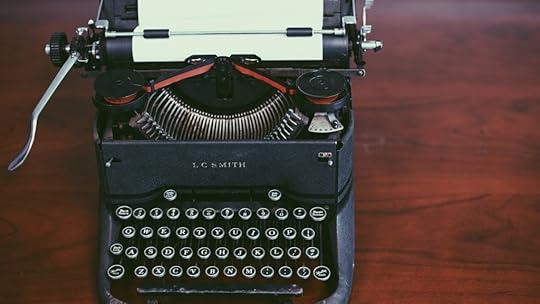
What Is a Character Archetype?
Merriam-Webster defines archetype as “the original pattern or model of which all things of the same type are representations or copies.”
A character archetype is a pattern of behavior inherent in a vast number of people.
If you think this method will make your writing too predictable, remember: you’re in control of the story. A character archetype is merely a pattern—and, just like real human beings, every character has his own quirks and idiosyncrasies that make him unique.
So then, how do you take a character archetype and use it as a starting place to create a unique character?
How to Use Character Archetypes
While the study of character archetypes can be helpful for character development, be careful not to let it influence you too much.
Educate yourself, read stories that feature the kind of characters you wish to create, then set everything aside and let your imagination take over.
Create unique characters that make sense and tell your story.
12 Common Types of Character Archetypes (with Examples)

There are hundreds of character archetypes with their own categories and subcategories—far too many to list in one post. All can be useful tools in creating believable characters.
A few of the most common (based on personality tests like the Enneagram):
1. The Reformer
Always a leader. He has a deep desire to do right, to feel useful and valuable.
He’s rational, idealistic, principled, and at his best has self-control.
At his worst, he’s a perfectionist. He fears failure.
Conflict comes easily. Others must see things his way, or he becomes critical and cutting.
Examples: Atticus Finch in To Kill A Mockingbird and Lady Isobel Crawley in Downton Abbey
2. The Helper
Always focused on improving the lives of others, he truly feels privileged that others choose him to be a part of their lives.
He does everything to keep people from harm. He’s humble, thoughtful, compassionate, generous, and loyal.
He has a tendency to be overprotective and loyal to a fault. He’s a people pleaser. He wants to be loved and will bend over backwards to make that happen. He manipulates people with his good nature.
The helper wants to avoid conflict, to the point that he often plays the martyr.
Example: Robert McCall in The Equalizer
3. The Individualist
By definition, he likes to be alone but doesn’t necessarily always prefer it.
He’s a creative visionary who hates restrictions. I’m sure it won’t shock you to learn that he’s also an independent thinker.
At his worst, he’s fragile. He cares deeply about what others think of him.
While he wants to be loved, he feels no one knows him well enough to love him fully—so, he usually ends up alone, or just aloof when he’s with people.
The individualist is a bear when it comes to conflict, because he loves to dredge up the past.
Example: Blanche Dubois in A Streetcar Named Desire
4. The Achiever
An ambitious, successful individual usually seen as a role model. He’s success-oriented: practical, flexible, and driven.
But he’s very concerned about how others see him.
He needs to feel important and valuable to those he loves. One of his worst fears is becoming irrelevant or useless. In conflict, he needs to be right and will go to great lengths to prove he is.
Example: Frasier Crane in Frasier
5. The Investigator
By definition, he enjoys discovering why things work the way they do. Problem solving is what he does best.
He’s brave, determined, intelligent, and creative. He loves exploring the unknown.
At his worst, the investigator is a loner. To his credit, he’s also an observer. He feels it best to take things in from a distance and contemplate, keeping his information close to the vest. He trusts only a very few people.
In conflict, the investigator is usually the calm, rational one because, remember, he’s the problem solver. He’ll ask lots of questions and get to the bottom of it one way or another.
Examples: Fox Mulder in X-Files, Sherlock Holmes
6. The Peacemaker
More than anything, he wants everyone to get along. He’s content, easy going, modest, and unassuming. He trusts easily and is emotionally stable.
At his worst, he’s complacent. He’s a worrier. He’s not someone who enjoys being assertive, unless he has to be. He avoids conflict and often will go along just to get along.
Example: Mr. Rogers in Mister Rogers’ Neighborhood
7. The Challenger
A strong leader who takes charge, he’s protective of himself and those he loves.
He’s self-assured and makes decisions quickly. Friends of a challenger never wonder where they stand.
He fears losing control. Because of this, in conflict, he’s going to win one way or another.
Example: Tony Soprano in The Sopranos
8. The Loyalist
That solid friend everyone wants in their corner, he can be trusted for the long haul, always the responsible one.
He needs loyal friends who trust and support him. He deals with stress by getting defensive and anxious.
The loyalist doesn’t deal well with conflict and easily believes he’s the persecuted one. He wants, more than anything, to feel secure.
Examples: George Costanza in Seinfeld, Frodo Baggins in Lord of the Rings
9. The Enthusiast
A fun person, he’s always the happiest in the room.
He’s uninhibited, flexible, and excitable. He’s always on the go and acts on impulse. He’s usually independent, smart, and productive.
At his worst, an enthusiast is scattered. He tends to take on too many things at once, because he never wants to miss a thing. Boredom is not acceptable.
In conflict, he’ll do anything to avoid pain, so he often becomes combative.
Example: Ace Ventura in Ace Ventura: Pet Detective
10. The Sage
That wise, intelligent guy who always knows the right thing to do, he’s a mentor, a solid friend, and usually there to assist the hero in his quest for what’s right.
The sage is constantly studying to discover truth. He’s often a pastor, a teacher, sometimes an investigator, and always an observer.
At his worst, he can be prideful. Procrastination is his middle name. In conflict, he can tend to be a know-it-all.
Examples: Gandalf from Lord of the Rings, Professor Albus Dumbledore in Harry Potter
11. The Protector
Great at both working alone and with people, he tends to accomplish more alone.
He leads by doing. He’s a warrior, an excellent teacher, compassionate, and honorable.
Watch out, though. The protector can often have a stubborn streak, and he gets impatient if he can’t help fix a problem. After a conflict, he struggles to forgive and forget.
Example: William Wallace in Braveheart
12. The Villain
Opposite the hero, this guy creates the need for a hero in the first place.
He has many likeable qualities—he’s a kind, worthy opponent, but something terrible in his past influenced who he has become—vengeful, proud, power hungry, merciless, and a guy who will stop at nothing to get what he wants.
Examples: White Witch in Chronicles of Narnia, Joker in Batman.
Use these Character Archetypes to Develop Your Own Characters
Learn to recognize character archetypes in people you know, in magazine advertisements and television commercials, or in television shows and movies.
But remember, as you write, let your imagination take over.
Trust your gut.
Tell a story that makes sense, with realistic characters who possess real emotions. Be careful not to create cookie-cutter characters—instead, create unique characters your readers long to know more about.
That’ll keep them coming back for more.
Tami Nantz is a freelance writer. She lives with her family near Washington, D.C. More of her work can be found at TamiNantz.com.
Related Posts:
How to Write a Book: Everything You Need to Know in 20 Steps
How to Publish a Book: My Ultimate Guide From 40+ Years of Experience
How to Develop a Great Story Idea
The post 12 Character Archetypes You Can Use to Create Heroes Your Reader Will Love appeared first on Jerry Jenkins | Proven Writing Tips.
November 4, 2019
How to Start Writing Your Memoir
Guest post by Joe Bunting
How do you start writing a book about your life? How do you take your whole lived experience, all the memories and emotions and events, and then write a first page? Or even a first sentence?
It’s not easy, right? I’ve written a memoir, a real life adventure story set in France called Crowdsourcing Paris, and yet the thought of starting a new book about my life is stressful. There’s so much to choose from, so many stories to tell.
How do you do it? How do you start a memoir? In this post, that’s the question I want to answer for you. If I were starting a new memoir today, taking everything I’ve learned from writing over ten books, this is what I would do.
How NOT to Start Your Memoir
Most people just start writing. They pick a place in their life, often when they were born, and just start.
This is what I did, too. It’s also why, by the time my memoir was published, I had deleted or rewritten over 20,000 words from the beginning.
I didn’t have a plan for my memoir, and because I didn’t have a plan, it made the whole writing process ten times harder.
It wasn’t until my second draft that I realized how important a plan could be for a memoir. I should have known better. I had used book plans for every book I’d written before, but because memoir felt different, easier somehow, I skipped the planning process. It was the biggest mistake I made.
How do you plan, though?
The 3 First Steps to Start a Memoir
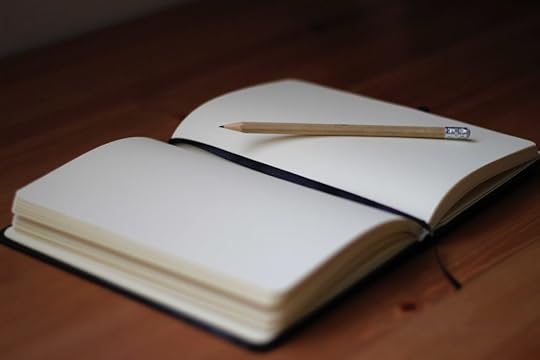
1. Write a Premise
The first step to write a memoir is to summarize your whole memoir idea in one sentence.
You might be thinking, “Wait. How do I summarize my whole life in a single sentence?”
And the answer is, you don’t. Because here’s the thing: most first-time memoir writers want to tell their whole life story in their book. But that’s not actually what memoir is good for. Great memoirs, stories like Wild and Eat, Pray, Love, are about a specific situation in a person’s life and the lesson they learned from that situation.
You can’t write a memoir about your whole life, and if you tried, it wouldn’t be a very good memoir. Instead, do this:
Write a memoir about only what you can fit in a single sentence.
Your single-sentence memoir premise should contain three things:
A character (i.e. you) in two wordsA situation A lesson
Here’s an example from my memoir Crowdsourcing Paris:
To raise $600 for his dream Paris trip, a cautious writer accomplishes 12 uncomfortable adventures given by his Internet followers, and through it all learns that the best stories come when you get out of your comfort zone.
Let’s break it down, based on the 3 elements of a memoir premise. First, you have a character, a cautious writer; then you have a situation, not quite enough money to make it in Paris; finally you have a lesson, the best stories come when you get out of your comfort zone.
How can you share your memoir idea in a single-sentence premise?
2. Create a Memoir Plan
A good plan is more than an outline. I’m a big fan of outlines, but if you identify more as a pantser than a planner, a memoir plan will still be a huge help.
I’ve found that writers who start with a plan are much more likely to finish their books. In fact, I’ve found with my 100 Day Book students that those who created a book plan before they started writing their books were 52 percent more likely to finish their books within 100 days.
What does a memoir plan contain? I include 10 things:
Premise. You’ve done this already above!Deadline. As Jerry says, “ Establish a sacred deadline. ” We all need deadlines to accomplish our goals, and a memoir is no different.Consequences. But a deadline alone isn’t enough. You also need a consequence to give your deadline teeth. If you have a traditional publishing deal, your consequence is that if you don’t hit the deadline your publisher will be upset and may eventually require you to return your book advance. For me, when I was writing Crowdsourcing Paris, I wrote a $1,000 check to the presidential candidate I most disagreed with and asked a friend to send it if I didn’t hit my deadline. I was very focused!Genre. What type of story are you writing? For example, it could be an adventure story (as Crowdsourcing Paris is), or a love story (like Eat, Pray, Love), or a coming of age story.Intention. You’re more likely to get into a writing habit and accomplish your goals if you imagine yourself doing the work. So imagine when, where, and how much you will write each day. Then, write it in your plan.Team. No one can write a book alone. All books are, at some level, crowdsourced. I find it’s good to make three lists: people who will hold me accountable, other writers who will give me feedback during the process, and one or two editors who will give me professional feedback.Inspiration. “Books are made from books,” Cormac McCarthy said. What other books will inspire you during the writing process, preferably other memoirs that tell the same type of story?Reader Avatar. You can’t make everyone happy. But you can make one person happy. Who is the one person you will think of when you write your book?Personal Marketing. Thinking about the writing process from beginning to end, even through the publishing and marketing process, will make you much more likely to actually get to the end. So spend some time thinking about what kind of marketing you will do for your book after it’s published.Chapter-by-Chapter Summary. Only after going through all of the previous steps do I spend time outlining my book. Why? Because outlines change throughout the writing process, but if you have a deadline and consequences, you’ll finish your book no matter what. Spend time outlining, yes, but don’t make it the only or even the most important part of your planning process.
So that’s the memoir plan. To get a handy worksheet to fill each of these out, you can find my memoir plan worksheet here.
3. Write Imperfectly
First drafts are almost always terrible.
The goal for the first draft of your memoir shouldn’t be to write a perfect draft. That’s impossible.
Instead, try to write the worst first draft ever.
Perfectionism will derail your writing faster than any other thing, leaving you mired in writer’s block.
Instead, be aggressive about ridding yourself of perfectionism for your first draft by actively trying to write the very worst first draft you can.
Just throw your story onto the page, full of comma splices, awkward dialogue, and all the typos in the world.
The amazing thing is that if you’ve done the planning process right, your draft will probably turn out pretty good, or at least good enough to get started with the second draft and make your book much better.
It’s Time to Start Your Memoir
Writing a memoir isn’t easy. For me, it took five years of blood, sweat, and tears.
But it was so worth it.
Someone told me recently of Crowdsourcing Paris, “I’ll be thinking about your memoir for the rest of my life.”
When your story can connect with readers at such a deep level, it makes all of the hard work of writing a memoir worth every moment.
So get started.

Joe Bunting is the author of the new book Crowdsourcing Paris, a real life adventure story set in Paris, now available here. If you’re writing a memoir, you can also click here to get a free guide with 10 tools every memoir writer needs.
Related Posts:
How to Write Dialogue That Captivates Your Reader
Voice in Writing: How to Find Yours
How to Improve Your Writing Skills: 15 Simple Tips
The post How to Start Writing Your Memoir appeared first on Jerry Jenkins | Proven Writing Tips.
October 22, 2019
7 Story Structures Any Writer Can Use
You may have a great story but no idea where to start. Whether an Outliner or a Pantser, you need an idea of where you’re going.
So….
Where do you begin? What’s the middle supposed to look like? How do you craft a resounding ending ?
You need a basic story structure, and the good news is that there are many to choose from.
Below, I’ll share 7 story structures that have worked for many best-selling authors, beginning with the one that revolutionized my career and has informed every novel I’ve written since the 1980s.
But what works for me might not work for you. So peruse these and try a few on for size. Something is bound to make sense and give you a leg up on crafting your novel.
Table of Contents
What is Story Structure? Story Structure Elements An Opener An Inciting Incident That Changes Everything A Series of Crises That Build Tension A Climax An End 7 Story Structures Dean Koontz’s Classic Story Structure In Medias Res The Hero’s Journey The 7-Point Story Structure Randy Ingermanson’s Snowflake Method The Three-Act Structure James Scott Bell’s a Disturbance and Two Doorways
What Is Story Structure?
Structure is to a story what the skeleton is to the human body.
The structure you choose for your story should help you align and sequence:
The ConflictThe ClimaxAnd the Resolution
The order in which you tell your story determines how effectively you create drama, intrigue, and tension, all designed to grab readers from the start and keep them to the end.
Story Structure Elements
You’ll find varying labels for various fiction elements, but really they’re largely similar. All stories include some version of:
1. An Opener
Start with who your story is about and establish the problem, challenge, quest, journey, or dilemma he* faces — and it must carry stakes dire enough to justify an entire book about it. Your goal here is to get your reader invested in the main character and what he must accomplish.
*I use the masculine pronoun inclusively to mean male or female characters.
2. An Inciting Incident that Changes Everything
It’s one thing to render a character frustrated by the status quo or angry at some annoying opponent. But get to the catalyst that forces him to act. The consequences for failing must be dire — way more than frustration or embarrassment. Think of the worst possible result and have your lead character spend the rest of the story battling to prevent it.
3. A Series of Crises that Build Tension
These should be logical—not the result of chance or coincidence—and they should grow progressively worse. In the process of trying to fix things, your protagonist will be building new muscles and gaining skills that will serve him in the end.
4. A Climax
Don’t mistake the Climax for the End. This is where your character appears to have fatally failed and everything appears hopeless.
5. An End
The resolution concludes your story. Your main character must succeed or fail, based on what he’s learned from the crises throughout. This is also where you tie up loose ends and satisfy your reader, while at the same time leaving him wanting more.
7 Story Structures
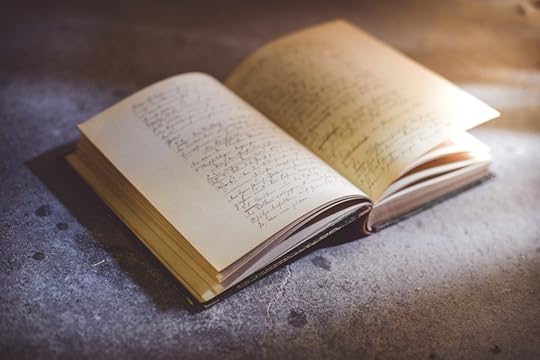
1. Dean Koontz’s Classic Story Structure
This is the structure that changed the path of my career as a writer.
It catapulted me from a mid-list genre novelist to a 21-Time New York Times bestselling author.
I’m a Pantser, not an Outliner, but even I need some basic structure to know where I’m going, I love that Koontz’s structure is so simple. It consists only of these four steps:
1. Plunge your main character into terrible trouble as soon as possible. Naturally that trouble depends on your genre, but in short, it’s the worst possible dilemma you can think of for your main character. For a thriller, it might be a life or death situation. In a romance novel, it could mean a young woman must decide between two equally qualified suitors—and then her choice is revealed a disaster.
And again, this trouble must bear stakes dire high enough to carry the entire novel.
One caveat: whatever the dilemma, it will mean little to readers if they don’t first find reasons to care about your character.
2. Everything your character does to get out of the terrible trouble makes things only worse. Avoid the temptation to make life easy for your protagonist. Every complication must proceed logically from the one before it, and things must grow progressively worse until….
3. The situation appears hopeless. Novelist Angela Hunt refers to this as The Bleakest Moment. Even you should wonder how you’re ever going to write your character out of this.
Your predicament is so hopeless that your lead must use every new muscle and technique gained from facing a book full of obstacles to become heroic and prove that things only appeared beyond repair.
4. Finally, your hero succeeds (or fails*) against all odds. Reward readers with the payoff they expected by keeping your hero on stage, taking action.
*Occasionally sad endings resonate with readers.
2. In Medias Res
This is Latin for “in the midst of things,” in other words, start with something happening. It doesn’t have to be slam-bang action, unless that fits your genre. The important thing is that the reader gets the sense he’s in the middle of something.
That means not wasting two or three pages on backstory or setting or description. These can all be layered in as the story progresses. Beginning a novel In Medias Res means cutting the fluff and jumping straight into the story.
Toni Morrison’s 1997 novel Paradise begins “They shoot the white girl first.”—the epitome of starting in medias res.
What makes In Medias Res work?
It’s all in the hook.
In Medias Res should invest your reader in your story from the get-go, virtually forcing him to keep reading.
The rest of the In Media Res structure consists of:
Rising ActionExplanation (backstory)ClimaxFalling ActionResolution
3. The Hero’s Journey
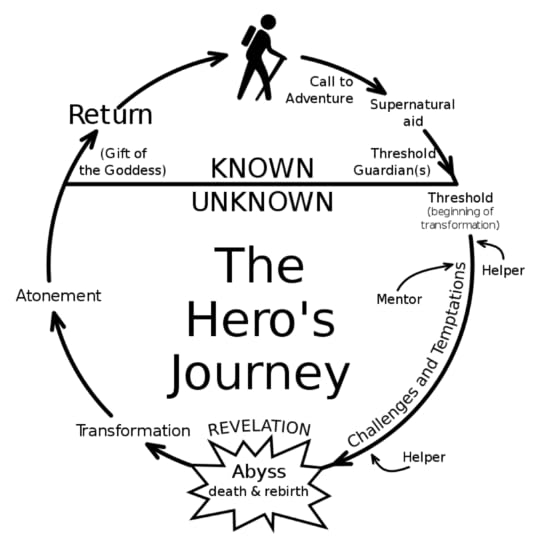
Made famous by educator and widely published author Joseph Campbell, it’s often used to structure fantasy, science fiction, and horror novels.
J.R.R. Tolkien used The Hero’s Journey structure for The Hobbit.
Step 1: Bilbo Baggins leaves his ordinary world
Baggins is happy with his life in the Shire and initially refuses a call to adventure, preferring to stay home.
The wizard Gandalf (soon to be his mentor) pushes him to accept the call.
Baggins leaves the comfort of his Hobbit life and embarks on a perilous quest across Middle Earth, getting into all kinds of trouble along the way.
Step 2: Baggins experiences various trials and challenges
Bilbo builds a team, pairing with dwarves and elves to defeat enemies like dragons and orcs.
Along the way he faces a series of tests that push his courage and abilities beyond what he thought possible.
Eventually, against all odds, Bilbo reaches the inmost cave, the lair of the fearsome dragon, Smaug where the ultimate goal of his quest is located. Bilbo needs to steal the dwarves’ treasure back from Smaug.
Bilbo soon finds he needs to push past his greatest fear to survive.
Step 3: Bilbo tries to returns to his life in The Shire
Smaug may have been defeated, but the dwarves face another battle against others and an orc army.
Near the end of the novel, Bilbo is hit on the head during the final battle and presumed dead.
But he lives and gets to return to the Shire, no longer the same Hobbit who hated adventure.
4. The 7-Point Story Structure
Advocates of this approach advise starting with your resolution and working backwards.
This ensures a dramatic character arc for your hero.
J.K. Rowling used the 7-Point Structure for Harry Potter and the Philosopher’s Stone.
The Seven Points
Hook: your protagonist’s starting point
In Philosopher’s Stone, this is when we meet Harry living under the stairs.
Plot turn 1: introduces the conflict that moves the story to its midpoint.
Harry finds out he is a wizard.
Pinch point 1: applies pressure to your protagonist in the process of achieving his goal, usually facing an antagonist.
When the trolls attacks, Harry and his friends realize they are the only ones who can save the day.
Midpoint: your character responds to conflict with action.
Harry and his friends learn of the Philosopher’s Stone and determine to find it before Voldemort does.
Pinch point 2: More pressure makes it harder for your character to achieve his goal.
Harry has to face the villain alone after losing Ron and Hermione during their quest to find the stone.
Plot turn 2: Moves the story from the midpoint to the resolution. Your protagonist has everything he needs to achieve the goal.
When the mirror reveals Harry Potter’s intentions are pure, he is given the Philosopher’s Stone.
Resolution: The climax. Everything in your story leads to this moment, a direct contrast to how your character began his journey.
Harry defeats Voldemort.
5. Randy Ingermanson’s Snowflake Method
If you like outlining your story, you’ll love The Snowflake Method.
But if you’re a Panster like me (someone who prefers to write by process of discovery), a story structure like Dean Koontz’s Classic Story Structure or In Medias Res might feel more natural.
The 10-step Snowflake Method
Start with one central idea and systematically add more ideas to create your plot.
Write a one-sentence summary of your novel (1 hour)Expand this into a full paragraph summary, detailing major events (1 hour)Write a one-page summary for each character (1 hour each)Expand each sentence in #2 into a paragraph summary (several hours)Write a one-page account of the story from the perspective of each major character (1-2 days)Expand each paragraph you wrote for #4 into a full-page synopsis (1 week)Expand your character descriptions into full character charts (1 week)Using the summary from #6, list every scene you’ll need to finish the novelWrite a multi-paragraph description for each sceneWrite your first draft
6. The Three-Act Structure
This formula was used by ancient Greeks, and it’s one of Hollywood’s favorite ways to tell a story.
It’s about as simple as you can get.
Act I: The Set-Up
Introduce your main characters and establish the setting.
Brandon Sanderson, a popular fantasy writer, calls this the “inciting incident”— a problem that yanks the protagonist out of his comfort zone and establishes the direction of the story.
Act II: The Confrontation
Create a problem that appears small on the surface but becomes more complex. The more your protagonist tries to get what he wants, the more impossible it seems to solve the problem.
Act III: The Resolution
A good ending has:
High stakes: your reader must feel that one more mistake will result in disaster for the protagonist.Challenges and growth: By the end, the protagonist needs to have grown as a person by overcoming myriad obstacles.A solution: All the trials and lessons your character has endured help him solve the problem.
Suzanne Collins’s bestselling young adult trilogy, The Hunger Games, uses the three-act structure.
7. James Scott Bell’s A Disturbance and Two Doorways
In his popular book Plot and Structure, Bell introduces this concept.
A Disturbance early in the story upsets the status quo—anything that threatens the protagonist’s ordinary life.
Doorway 1 propels your character to the middle of the story. Once he goes through this door, there’s no turning back.
Doorway 2 leads to the final battle. It’s another door of no return but usually leads to disaster.
The Umbrella Academy by Gerard Way uses this story structure.
Upon hearing that their adoptive father has passed away (the disturbance), six siblings return to their childhood home.
Here they learn the world will end in a few days (Doorway 1). While the siblings try everything in their power to stop the potential global apocalypse, they unwittingly create another threat amongst themselves.
This leads to a final battle (Doorway 2).
More in-depth Story Structure plotting resources:
Plot and Structure by James Scott Bell The Secrets of Story Structure by K. M. WeilandRandy Ingermanson’s Snowflake Method
Related Posts:
How to Write Dialogue That Captivates Your Reader
Show, Don’t Tell: What You Need to Know
40 Writing Tips Experts Wish They’d Known as Beginners
The post 7 Story Structures Any Writer Can Use appeared first on Jerry Jenkins | Proven Writing Tips.
October 10, 2019
How to Write Dialogue That Captivates Your Reader
If your writing bores you, it’ll put your reader to sleep.
And unfortunately, your first reader will be an agent or an editor.
Your job is to make every word count—the only way to keep your reader riveted until the end, no small task.
Riveting dialogue is your friend because it can accomplish so many things:
It breaks up narrative summary.It differentiates characters (through dialect and word choice ).It moves the story, showing without telling.
But writing dialogue well is not easy. If yours is bloated or obvious or telling, readers won’t stay with you long.
Need help writing your novel? Click here to download my ultimate 12-step guide.
How to Write Effective Dialogue in 6 Steps
Cut to the Bone Reveal Backstory Reveal Character Be Subtle Read Your Dialogue Out Loud Create a “Make My Day” Moment
Step 1. Cut to the Bone
Unless you’re including them to reveal a character as a brainiac or a blowhard, omit needless words.
Obviously, you wouldn’t render a conversation the way a court transcript includes repetition and even um, ah, uh, etc.
See how much you can chop while virtually communicating the same point. It’s more the way real people talk anyway.
Like this:
“What do you want to do
this
Sunday?
I thought
w
We
could go to the amusement park.”
“I was thinking about renting a rowboat,” Vladimir said.
“On one of the lakes.”
“Oh,
Vladimir,
that sounds wonderful! I’ve never gone
rowing
before.”
That doesn’t mean all your dialogue has to be choppy—just cut the dead wood.
You’ll be surprised by how much power it adds.
Step 2. Reveal Backstory

Layering in backstory via dialogue helps keep your reader engaged.
Hinting at some incident introduces a setup that demands a payoff.
As they headed toward the house, Janet whispered, “Can we not bring up Cincinnati?”
Maggie shot her a double take. “Believe me, I don’t want that any more than you do.”
“Good,” Janet said. “I mean—”
“Can we not talk about it, please?”
What normal reader wouldn’t assume they will talk about it and stay with the story until they do?
As the story progresses, reveal more and more about your protagonist’s past.
This both offers setups that should engage your reader, and it allows you to avoid relying on cliched flashbacks.
Need help writing your novel? Click here to download my ultimate 12-step guide.
Step 3. Reveal Character
Your reader learns a lot about your characters through dialogue.
You don’t have to TELL us they’re sarcastic, witty, narcissistic, kind, or anything else.
You can SHOW us by how they interact and by what they say.
Step 4. Be Subtle
Dialogue offers a number of ways to powerfully understate things.
Here are three:
1. Subtext—where people say other than what they mean.
Cindy falls in love with the slightly older boy next door, who sees her as just a little sister type.
When she gets to high school, Tommy is already captain of the football team, dating the head cheerleader, and largely ignoring Cindy.
Tommy leaves for college and word soon gets back to Cindy during her senior year of high school that he and his girlfriend have broken up.
So when he comes home after his freshman year of college and is changing a tire on his car, Cindy just happens to walk outside. She strikes up a conversation with Tommy, and he looks up, stunned. Who is this beauty—little Cindy from next door?
She says, “Making a change, are you?”
Tommy looks at the tire and back at her and says, “Yeah, I actually am making a change.”
Cindy says, “Well, I’ve heard that rotating can be a good thing.”
And he says, “Yeah, I’ve heard that too.”
That’s subtext. They’re not saying what they really mean. They’re not really talking about changing the tire, are they?
2. Sidestepping—when a character responds to a question by ignoring it.
Instead, he offers a whole new perspective.
In the movie Patch Adams, the late Robin Williams played a brilliant young doctor who believes the Old Testament adage that “laughter is the best medicine.”
In the children’s cancer ward he wears an inflated surgical glove on his head, making him look like a rooster. He wears bedpans for shoes and stomps about, flapping his arms and squawking.
The children find it hilarious, but hospital directors consider it undignified and demand he stop.
Patch is trying to make one girl in particular—a hospital volunteer—laugh. But while everyone else thinks he’s funny, she never cracks a smile.
Finally, Patch leaves the hospital to open a clinic in the country. Imagine his surprise when that humorless young lady appears to help him set up.
At one point, she goes outside to rest, so Patch follows and sits opposite her. He says, “I’ve got to ask. Everybody thinks I’m hysterical, but you. I’ve tried everything. Why don’t you ever think anything I say is funny?”
After several seconds, she says, “Men have liked me all my life…all my life…” And we realize by the way she says it, she was abused as a child.
Suddenly, we understand what this girl is all about. She doesn’t trust men, and she doesn’t laugh, because life isn’t funny.
She had not really answered his question. Her problem had nothing to do with him or his humor.
Finally, Patch realizes that some things aren’t funny. Some things you just don’t make fun of.
It’s a great turnaround in the story. And an example of sidestep dialogue.
3. Silence
Silence truly can be golden.
Many, including Abraham Lincoln, have been credited with the line: “Better to remain silent and be thought a fool than to speak and remove all doubt.”
One of the toughest things to learn as a writer is to avoid filling silent gaps.
Just like we shouldn’t tell what’s not happening in a story, neither do we need to write that someone didn’t respond or didn’t answer.
If you don’t say they did, the reader will know they didn’t.
“Well, John,” Linda said, “what do you have to say for yourself?”
John set his jaw and stared out the window.
“I’m waiting,” she said.
He lit a cigarette.
Linda shook her head. “I swear, John, honestly.”
Too many writers feel the need to write here, “But he refused to say anything,” or “But he never responded.”
Don’t! We know, we get it—and it’s loud, effective, silent dialogue.
Saying nothing, John is actually saying everything.
Step 5. Read Your Dialogue Out Loud

One way to be certain your dialogue flows is to read it aloud or even act it out.
Anything that doesn’t sound right won’t read right either, so rewrite it until it does.
Step 6. Create a “Make My Day” Moment
Certain iconic lines of dialogue have become as legendary as the films and books they originate from:
“Frankly my dear…”“There’s no place like home.”“We’re not in Kansas anymore.”“To my big brother George, the richest man in town.”“What we have here is failure to communicate.”“Go ahead, make my day.”“May the force be with you.”“Houston, we have a problem.”“Run, Forrest, run!”“You had me at hello.”
Most writers—even bestselling novelists—never create such an unforgettable line of dialogue. But striving to create one is worth the effort.
Ironically, it should fit so seamlessly it doesn’t draw attention to itself until fans begin quoting it.
How to Format Dialogue
1. Use Dialogue Tags
Attribution tags—he said, she said, etc.—are usually all you need to indicate who’s speaking, so resist the urge to get creative.
Teachers who urge you to find alternatives are usually unpublished and believe agents and editors will be impressed.
Trust me, they won’t be.
Avoid mannerisms of attribution. People say things. They don’t wheeze, gasp, sigh, laugh, grunt, or snort them.
They might do any of those things while saying them, which might be worth mentioning, but the emphasis should be on what is said, and readers just need to know who is saying it.
Keep it simple. All those other descriptors turn the spotlight on an intrusive writer.
Sometimes people whisper or shout or mumble, but let their choice of words indicate they’re grumbling, etc.
If it’s important that they sigh or laugh, separate that action from the dialogue.
Jim sighed. “I can’t take this anymore.”
Not: Jim sighed, “I can’t take this anymore.”
Though you read them in school readers and classic fiction, attribution tags such as replied, retorted, exclaimed, and declared have become clichéd and archaic.
You’ll still see them occasionally, but I suggest avoiding them.
Often no attribution is needed.
Use dialogue tags only when the reader wouldn’t otherwise know who’s speaking.
I once wrote an entire novel, The Last Operative, without attributing a single line of dialogue.
Not a said, an asked, anything.
I made clear through action who was speaking, and not one reader, even my editor, noticed.
Jordan shook his head and sighed. “I’ve had it.”
Another common error is having characters address each other by name too often.
Real people rarely do this, and it often seems planted only to avoid a dialogue tag. Fictional dialogue should sound real.
Don’t start your dialogue attribution tag with said.
…said Joe or …said Mary reads like a children’s book. Substitute he and she for the names and that will make it obvious: …said he or said she just doesn’t sound right.
Rather, end with said for the most natural sound: …Joe said or …Mary said.
Resist the urge to explain, and give the reader credit.
The amateur writer often writes something like this:
“I’m beat,” exclaimed John tiredly.
Besides telling and not showing—violating a cardinal rule of writing—it uses the archaic exclaimed for said, misplaces that before the name rather than after, and adds the redundant tiredly (explaining something that needs no explanation).
The pro would write:
John dropped onto the couch. “I’m beat.”
That shows rather than tells, and the action (dropped onto the couch) tells who’s speaking.
2. How to Punctuate Dialogue
Few things expose a beginner like incorrect punctuation, especially in dialogue.
Agents and editors justifiably wonder if you read dialogue, let alone whether you can write it, if you write something like: “I don’t know.” she said. Or, “What do you think?” He said.
To avoid common mistakes:
When dialogue ends with a question or exclamation mark, the dialogue tag following the quotation marks should be lowercase: “I’m glad you’re here!” she said.When one character’s dialogue extends to more than one paragraph, start each subsequent paragraph with a double quotation mark, and place your closing double quotation mark only at the end of the final paragraph.Place punctuation inside the quotation marks, the dialogue tag outside: “John was just here asking about you,” Bill said.Put the attribution after the first clause of a compound sentence: “Not tonight,” he said, “not in this weather.”Action before dialogue requires a separate sentence: Anna shook her head. “I can’t believe she’s gone!”Quoting within a quote requires single quotation marks: “Lucy, Mom specifically said, ‘Do not cut your bangs,’ and you did it anyway!”When action or attribution interrupts dialogue, use lowercase as dialogue resumes: “That,” she said, “hurt bad.”
3. Every New Speaker Requires a New Paragraph
Here’s how I handled a conversation between Brady, one of my lead characters, and his attorney, in my novel Riven:
Ravinia sat shaking her head and telling him all the reasons it would never fly. Rules, regulations, protocol, procedure, no exceptions, and the list went on and on. “I’m not going to pursue this for you, Brady.”
“Yes, you are. I can tell.”
“You can’t tell it by me. Have you been listening? It’s impossible…”
“But you’ll try.”
Ravinia rolled her eyes. “I wouldn’t even know where to start.”
“Sure you would. You know everything, and you’ve been working inside the system a long time.”
“I’d be laughed out of here,” she said.
“Just tell me you’ll try.”
“Brady, really, be serious. Think this through. Can you imagine the warden going for this? Huh-uh. No way.”
“I like your idea of starting with the warden,” he said.
“I said no such thing.”
“Start at the top; go right to the man.” …
“Brady, don’t ask me to do this.”
“I’m asking.”
Dialogue Examples
If you’re old enough to remember the original Twilight Zone (hosted by Rod Serling) or Dragnet (starring and narrated by Jack Webb), you know how dialogue set the tone for their shows.
Serling was sometimes whimsical, sometimes mysterious, but always provocative. “Consider one middle-aged adult, lost in space and time…”
Jack Webb, as L.A. police detective Sergeant Joe Friday, was always deadly serious and monotone. “Just the facts, ma’am.”
Contrast those with the dialogue between Tom and his Aunt Polly in Tom Sawyer.
“There! I mighta thought of that closet. What you been doing in there?”
“Nothing.”
“Nothing! Look at your hands. And look at your mouth. What IS that truck?”
“I don’t know, aunt.”
“Well, I know. It’s jam—that’s what it is. Forty times I’ve said if you didn’t let that jam alone I’d skin you. Hand me that switch.”
The switch hovered in the air—the peril was desperate—
“My! Look behind you, aunt!”
The old lady whirled round and snatched her skirts out of danger. The lad fled on the instant, scrambled up the highboard fence, and disappeared over it.
Such dialogue sets the tone for the entire story and clearly differentiates characters.
In Huckleberry Finn, Twain delineates between the Southern white boy and Jim, the runaway slave by hinting at their respective accents.
Twain doesn’t need to tell who’s speaking, yet the reader never confuses the two.
“Jim, did y’all ever see a king?”
Y’all is the only word in that sentence that implies a Southern accent, but it’s enough.
“I sho enough did.”
“You liar, Jim. You never seen no king.”
“I seen foh kings in a deck of cards.”
Huck’s grammar and Jim’s sho and foh are the only hints of their dialects.
Too much phonetic spelling would have slowed the reading.
The Cardinal Sin of Dialogue
The last thing you want is to produce on-the-nose dialogue.
Apply to your own work those principles and the tools I’ve outlined here, and I believe you’ll immediately see a huge difference. So will your reader.
Need help writing your novel? Click here to download my ultimate 12-step guide.
Related Posts:
How to Write a Book: Everything You Need to Know in 20 Steps
How to Publish a Book: My Ultimate Guide from 40+ Years of Experience
How to Overcome Writer’s Block Once and For All: My Surprising Solution
The post How to Write Dialogue That Captivates Your Reader appeared first on Jerry Jenkins | Proven Writing Tips.
September 24, 2019
Finding the Best Creative Writing Blogs on the Internet
Regardless how many books I’ve written or sold, if I’m not still educating myself about writing, I’m stagnating.
My late mother taught me the value of life-long learning. Not only was she a piano teacher into her eighties, but she was also a piano student.
One of the most powerful learning tools today is the internet. But you could surf through endless writing blogs before finally finding which are the best for you and worthy of your time.
So I asked my team to research what’s out there, and we’ve compiled a short list to get you started. But you also know how to search by specifying genres and areas of interest, so don’t stop here. Our list is by no means exhaustive, and I haven’t even included all the ones I enjoy.
Here, then, are just suggestions of a few blogs you might want to check out to start your own list of writing resources—and we list them in alphabetical order:

Become a Writer Today
Through his blog Become a Writer Today, Bryan Collins focuses on the needs of new writers.
A non-fiction writer, blogger, and podcaster, Bryan writes on those genres, as well as on self-publishing. He’s written two 3-book series, “Become a Better Writer Today” and “The Power of Creativity.”
A team of writers cover the business side of writing and such topics as writer’s block, formatting, and best practices.
The Creative Penn
A New York Times and USA Today bestselling thriller author, Joanna Penn is behind The Creative Penn.
She also writes books for writers—her 21 titles have sold more than a half million copies. She’s a speaker, an entrepreneur, runs Curl Up Press, and has been named one of the top 100 Creative Professionals in the UK.
Joanna’s blog focuses on self-publishing, marketing, and writing. The Creative Penn podcast offers more than 350 episodes on writing.
Creative Writing Now
Founded by writing teacher Nancy Strauss, Creative Writing Now offers courses, tips, prompts, and information on writing contests. Writing teachers will find lesson plans as well.
DIY MFA
DIY MFA serves as a do-it-yourself manual for the equivalent of a Master of Fine Arts in writing without the expense. It centers on writing with focus, reading with purpose, building your writing community, and how to discover the writing tools available online and off.
Founded by author and podcaster Gabriela Pereira, the site posts on everything from playwriting to surviving rejection, travel writing, and many other writing topics. She offers a “writer igniter” that generates writing prompts.
Jane Friedman
A must read for writers and publishers, blogger Jane Friedman is one of the leading voices in the digital age of publishing.
She has more than 20 years’ experience in the industry, publishes The Hot Sheet (a newsletter for authors), is a columnist for Publishers Weekly, a professor with The Great Courses (How to Publish Your Book), and wrote The Business of Being a Writer.
Jane’s blog offers how-to’s on publishing, writing a book proposal, finding a literary agent, and many other such topics.
Helping Writers Become Authors
Through her website Helping Writers Become Authors, K.M. Weiland has published more than 1,200 blog posts educating writers on the ins and outs and dos and don’ts of writing and publishing.
She offers a bi-monthly e-letter, a podcast, and a vlog. She writes historical and speculative fiction, as well as how-to books, including Outlining Your Novel and Structuring Your Novel.
Live Write Thrive
Novelist, copyeditor, and writing coach C.S. Lakin created Live Write Thrive to help write your novel with posts like “The Challenges of Believability in Writing Science Fiction” and “The 3 Ways to Show Emotion in Your Characters.”
Now Novel
Bridget and Brendan McNulty and Dagmar Timler co-founded Now Novel, a platform designed to help you craft your story.
The blog offers information for writers at every stage, a character writing hub, productivity tips, and help creating fantasy worlds.
Pro Writing Aid
Pro Writing Aid is a desktop app you can use with programs like Scrivener, Word, and Google Docs. It catches grammar errors, suggests style changes, and even checks your work for plagiarism.
Their blog covers which writing apps are best, the writing process, blogging and content writing, grammar rules, and business writing.
Write It Sideways
Founded by Suzannah Windsor, Write It Sideways is for aspiring and emerging writers.
A team of writers answers questions budding writers ask, and blogs on things like writer’s intuition,“Confessions of a Writing Group Virgin,” and “Here’s the Type of Hate Mail Bloggers Get.”
Writers Helping Writers
Authors Angela Ackerman and Becca Puglisi created Writers Helping Writers for new writers, seasoned writers, editors, and writing teachers. The blog offers advice on technique and strategy, as well as “Navigating the Changing Face of Book Promotion with Smart, Effective Strategies” and “How To Stop Self-Doubt From Holding You Back From Writing.”
The Write Practice
Joe Bunting started The Write Practice to help writers become better through practice.
He offers writing prompts and provides a platform for fellow writers to offer feedback on what you’ve written.
My Blog
And of course you’re always welcome to visit me at JerryJenkins.com.
Over the last half century I’ve been an editor, a publisher, a nonfiction author, and a novelist—yet I’m still learning and growing like you. I offer a 20-Step Guide on How to Write a Book, How to Develop a Great Story Idea, Find the Right Writers Group and How to Write Dialogue.
Time to Get to Work
The best mentoring comes from seasoned writers proven in their fields. So dive into these blog sites and commit to life-long learning.
Related Posts :
How to Write a Memoir: A 4-Step Guide
How to Improve Your Writing Skills: 15 Simple Tips
Show, Don’t Tell: What You Need to Know
The post Finding the Best Creative Writing Blogs on the Internet appeared first on Jerry Jenkins | Proven Writing Tips.



